#or the live action ewok movies of the '80s
Explore tagged Tumblr posts
Text
Hateration and holleration in a galaxy far, far away:
THE ACOLYTE: The unexpectedly decent ANDOR showed that a Mouse-infested Star War could still be thoughtful and even intermittently compelling, but everything since then (and a fair bit before) has been plumbing new depths of awfulness. This depressingly wretched new show, set 100 years before the movies and chronicling the adventures of former Jedi apprentice Osha Aniseya (Amandla Stenberg) whose evil twin Mae has just murdered a Jedi Master (Carrie-Anne Moss), is another for the garbage pile: unimaginative visuals (is the best they can do really warmed-over wuxia moves from 25–30 years ago?), painfully dreadful dialogue, and a who-cares plot whose clichés are too dull to be worth summarizing.
The principal cast (discounting Moss, who's killed off in the first scene) is embarrassingly bad, but such inept direction would leave even more competent actors drowning in a sea of cheap-looking CGI blandness. Worse, the story seems to lean into some of the most conceptually dreary aspects of the prequels; it feels like THE PHANTOM MENACE, from its framing of the Jedi Order as a collection of sociopaths to its ghastly racist Trade Federation caricatures. The only mitigating factor is that unlike AHOSKA or OBI-WAN KENOBI, it doesn't appear to contain any familiar SW characters to assassinate. CONTAINS LESBIANS? The Amandla Stenberg characters are from an all-female outlaw sect (and have two moms, one of them apparently trans) that's presented as ontologically evil and then genocided. VERDICT: Do even diehard SW fans still give a shit? If so, why?
#teevee#hateration holleration#star wars#the acolyte#leslye headland#amandla stenberg#carrie anne moss#one of those tie-ins that is not only bad#but also makes you forget what you ever liked about the thing#tedious and stupid#andor had its flaws#but it made a fair effort to be sw for grownups#this is like#jason of star command#or the live action ewok movies of the '80s#also why has star wars become so fixated#on presenting jedi masters as useless idiots#it's not just a matter of their being moral and philosophical disaster areas#they're just incredibly bad at their jobs#like how do you constantly fuck up this badly and have people take you seriously for a thousand generations?
7 notes
·
View notes
Text
My take (that no one asked for) on every single Star Wars show and non-saga movie:
The Clone Wars (movie): It’s…okay it’s rough. This wasn’t supposed to be a movie at all, putting three episodes of the show together and releasing it theatrically was part of the distribution deal with Cartoon Network, as far as I know, and it does show. It’s grown on me, though.
Clone Wars (The Tartakovsky Series): I think I’m probably in the minority here, but I actually don’t love this one. It’s fun, slick, and stylish, like everything Tartakovsky does is, and I don’t dislike it, but it just doesn’t do much for me. It’s cool. Maybe it’s a little too cool. Great art style, though.
The Clone Wars: Very high highs, very low lows. Though to be honest, I actually love a lot of the goofier episodes. They’re fun. It doesn’t have to be all drama all the time. Sometimes you can let Jar Jar be an agent of chaos. Sometimes you can have an episode about interest rates. I don’t have the nostalgia factor going with TCW the way a lot of people do—I didn’t watch it until I was in my twenties—so I do have to admit that it is tied with one other show as my least favorite of the animated shows, but that’s not a bad thing. I still love it.
Ewoks: I’ve only seen about six episodes. It’s veeerry 80’s. I think eight year old me would have gone insane for this show had I seen it. Adult me actually has a bit of a soft spot for it. I’ll watch the rest of it eventually. (Aaaand now I have the theme song stuck in my head. It’s. It’s definitely a theme song.)
Droids: I…haven’t seen it.
Resistance: I finally had a chance to get all the way through this show (I was eyeballs deep in “okay fine we’ll try this college thing AGAIN” when it was airing and just didn’t have time to check it out) and you know what? It’s actually pretty good. It’s definitely skewed even a little younger than Star Wars typically is, but it does what it does really well. Sort of feel like this one is slept on.
The Mandalorian: It’s a fantastic adventure of the week show. I actually don’t dislike the ���plot” episodes, but mostly I’m just here to watch what shenanigans Din and his small green force son get into. Season three is weaker than the first two, but I don’t even really think that season is bad. There was some great stuff in it—just uneven and mixed in with some not so great stuff. Overall, good popcorn viewing, as far as I’m concerned.
Andor: Okay, yeah, Andor is fantastic. I do think some of its popularity is that it’s one of two (maybe three) Star Wars shows made for adults more than anyone else, so some people don’t quite have the same “why isn’t this making me feel like Star Wars did when I was a kid?” dissonance watching it, but it is also genuinely amazing. Probably the best thing Star Wars has ever done even if it’s not technically my favorite.
The Book of Boba Fett: Is it a mess? Yes. Do I still enjoy it? Yeah. My main problem with BoBF is that it’s got some serious structural issues. Even besides Din coming in and taking over two whole episodes, I think that the telling the story via flashbacks was a mistake, and that we should have followed Boba through the childhood bits and slowly caught up to him in the present. Maybe revealed it was all a flashback while he was in the bacta tank from there. And I…don’t love Robert Rodriguez’s directorial style all that much, never really have. That said, I do hope we eventually get more of this, though if we do I think it will be folded into something else. Still don’t love the live action pike design. (I actually have a conspiracy theory that BoBF was originally just a few episodes or even a season of The Mandalorian, and that it was made its own thing for marketing purposes.) I want more Boba, more Fennec, and more Sand People, if nothing else.
Solo: One, killing off Val Beckett was a huge mistake. It’s not story breaking or anything like that, but doing so when she’s one of very few black women in Star Wars and half of one of, like, two interracial couples in the entire franchise means that it hits in a way it wouldn’t if she was someone else. So, yeah, don’t like that. Two, the rest of this movie is a blast and audiences just hate fun. I don’t care that no one asked for this movie, it’s fun and campy and there’s a heist and I like it. Three, Enfys Nest has the sickest armor design in the whole franchise and I need more of her.
Kenobi: So…maybe unpopular opinion here, but…I really like Kenobi. Kenobi’s a delight. It’s not perfect, it’s got some problems, but I like that it’s about a guy who’s that depressed and alone slowly regaining his sense of hope, I like that we had something focus on Leia for a while (because Anakin and Padme had two kids and Leia always gets left second string), I like that you’ve got grifters like Haja and former imperials doing what little bits they can to help even though they can’t fight the whole empire. And I know that thoughts are mixed on this, but I actually thought it made a couple bits of A New Hope make more sense where Leia is concerned; kid me could never figure out how she knew who Ben Kenobi was when that was the name he only went by in exile on Tattooine (“Ben Kenobi? Where is he!?”), and it kind of made the switch from the very formal request for aid on behalf of her father to the more personal, “Help me, Obi Wan Kenobi,” a little more poignant, for me, anyway. Reva is an amazing character, she’s a perfect parallel and eventually perfect foil for Anakin, she’s a mess and a he’s in pain and I just. I love her. I have mixed feelings on the live action Grand Inquisitor’s performance (and mixed feelings on the makeup—on the one hand it could be better and on the other hand the other main live action pau’an we’ve got—the actor’s head was just shaped like that). Nevertheless, this show for me was mostly about the big emotional beats, and it hit all of those really well.
The Bad Batch: This is a magnificent show and I adore it apart from That One Thing and the fact that everything was left completely open, even going into the epilogue, apart from Omega’s coming of age and the Hunter’s and Omega’s relationship’s arc. That was resolved very well. I am mildly insane about this show. I love it. Also, it vexes me. Tied with two other shows as my favorite Star Wars show in spite of all that. Amazing soundtrack. Sidebar: If it turns out I’m right and That One Thing is an extended fake out and we’re not quite done with these characters, I’m sorry, but I’m going to be the most insufferable person alive.
The Acolyte: Everyone is very pretty and just a little stupid. Mae is very fun. The good scenes are very, very good. The writing is pretty uneven; judging from interviews I have a completely different view of writing than Leslye Headland and had a hard time picking up why a lot of the characters did anything, but when it hit, it hit. It’s…very CW drama, which isn’t a bad thing—just not always my thing. That said, Sol is a fascinating concept for a character and Lee Jung-jae did an incredible job with what he was given. Same with Qimir and Manny Jacinto. It’s honestly not my favorite Star Wars show, but I’m still disappointed that it looks like it’s not moving forward. The leftover story might end up being folded into the high republic book series, but I still hope we get some kind of on-screen continuation. I think the public needs more of Darth Babe the Jacked.
Rogue One: It’s great. Yes, the entire main cast dies, but the central message was still about hope. Vader gets to pun. I remain somewhat dismayed that the only thing a portion of the audience took away from it was that the Vader hallway scene was cool. He’s a horror movie monster there. Still a great movie. (Also, Saw, why do you have that??)
Young Jedi Adventures: This skews very young; most Star Wars is for kids in the first place apart from Andor, the Acolyte, and mmaaaaaybe the Tales of anthology (the other live action shows are, in my opinion, solidly whole family), but this really is made for very young children. That said, I have watched it, and it’s a very well done show for very young kids. Also I would die and kill for Nubs.
The “Tales Of” anthology series: Yes, I am counting this as one, because even though there’s a shift in focus from the Jedi to the empire between seasons, it all follows the exact same format and structure. I’d argue this series is the one that’s primarily for the adults who either grew up watching Star Wars animation or got into it as adults. It’s good, lots of atmosphere, the episodes do range in quality but I generally like them, and it’s nice they get to play around with different techniques, like making miniatures and incorporating them into the animation. The Dooku and Barriss episodes are probably my favorites.
Ahsoka: I know the fandom is divided on this, like they are on most things, but I love this one, okay? It’s not perfect, but I have a good time watching it. It just happens to be this perfect blend of campy, fun, dramatic, and mystical that really feels like Star Wars for me. I like it when Star Wars gets weird, has silly little guys, and doesn’t take itself too seriously. Lucky for me that this series has extragalactic travel via whale, Ahsoka being dragged to Force Therapy by Anakin, and Ezra hanging out with the space fraggles. That, and I love some of the concepts. I like the idea that force sensitivity isn’t the be all end all, that connecting to the force is something you can learn with practice even if you weren’t blessed with the genetic lottery. Peridea and the space it occupies in folklore is neat. And the music is wonderful. It is a little uneven, it’s not Andor or anything quite that amazing, but I’m eager for more.
Visions: This anthology is fantastic and you’re missing out if you haven’t seen it. I don’t love every entry, but even the weaker ones are worth seeing once, and the stronger ones are worth seeing a whole lot more than that. It’s a great blend of styles and takes from people normally not involved in creating Star Wars. This is in a three way tie for my favorite Star Wars show.
Rebels: Again, it’s not perfect, because no show is, but I also think it’s the strongest standalone show Star Wars has besides Andor. Yes, there are weaker episodes, but on the whole it’s remarkably consistent, and the second half of season four might be some of my favorite Star Wars outside of parts of the original trilogy. Also, it has some stunning backgrounds, and while the art style doesn’t always work for every character, the character animation ends up really hitting its stride towards the end of the second season, and just gets better from there. And, as always, the music is fantastic. Rebels rounds out that three way tie for my favorite Star Wars show along with TBB and Visions.
#Star Wars#this is all just personal taste#I guess tldr is that I enjoy some more than others#but I enjoy basically all of it on some level
7 notes
·
View notes
Text
I realize Steve the pirate might be joking but there were SO MANY animated cartoons in the 80s and 90s based on every single successful movie including but not limited to: bill & ted, clerks, beetle juice, the mask, ace Ventura, ghostbusters, little shop of horrors, Ewoks/star wars, Rambo, teen wolf, police academy, robocop, karate kid, back to the future, Highlander, dumb & dumber, jumanji, men in black, the mummy, Godzilla, starship troopers…
I guess they realized that concept doesn’t super work anymore (ignoring like, Star Wars and Star Trek doing it) and so now they’re reversing it for some reason.
And tbh all those shows I listed above suck and most last one season. Maybe, just maybe, because by acting like animation and live action is interchangeable, you devalue both art forms. Hmm.
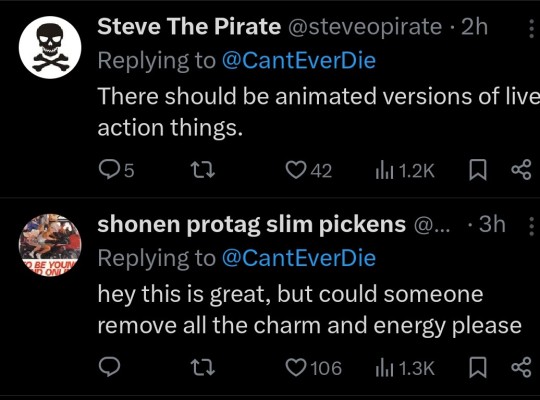

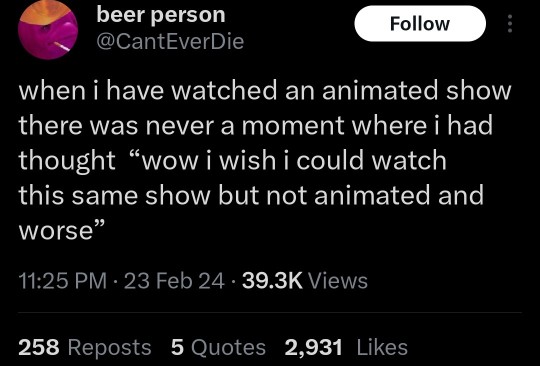
10K notes
·
View notes
Text
A very confused Star Wars Fan desperately tries to justify their belief that “Caravan of Courage” shows the way forward for the franchise. No, really.
Ever since I was a little kid, I’ve loved Star Wars. And I mean, all of it. The books, the games, the Lego, the spin-offs: I even enjoy the Holiday Special in a The Room so-bad-you-just-need-to-see-it sort of way. But particularly the films. But here is when we run into the big problem: I’m just the wrong age. The original trilogy launched before I was born, the prequel trilogy hit cinemas when I was already a teen and while I went and saw them and enjoyed them, I was at that age where I was self-conscious about seeing a “kids” film, and hyper-aware of how silly and cringy those films were in parts. So my indoctrination, my inoculation with the Star Wars bug didn’t happen in the cinema, and it didn’t happen with any of the main franchise works. It happened on home video, on a skiing trip in the French Alps in the early 90’s. I’d have been about 6, and this was the first time I’d ever been abroad other than to see relatives in Ireland. And I loved it: to this day I love skiing, but more than that, I have very, very fond childhood memories of this trip. This was shortly before I lost my biological mother to cancer, she’d have received her diagnosis just after we got back from the trip. This was when my younger sister stopped being an annoying screaming thing and became and became an actual person I could talk and play and share ideas with, this was before the combination my mothers long illness and my father having just launched his own IT start up meant I didn’t see him or her any more, despite the fact they were in the same house as me. This was this wonderful, nostalgic child-hood bubble when my family was intact, and nothing could ever go wrong. I skied all day with mum and dad, and would come back to the chalet in the evening. It was an English speaking chalet, I met my first real-life American there, and having grown up in the 90’s in the UK nothing was cooler than making friends with an actual American my own age. He had a hulk Hogan action figure with springs in the legs so if you put him on a hard surface and punched his head down, when you let go he’d jump really high in the air. We used to play with it together in the bath, back in that weird 90’s time-bubble when it was possible to convince two sets of parents that this kid you’d just met was you best friend in the world and of course shared bath time was, somehow, normal and appropriate. And fresh from bath time, tired from the day, the parents would give us some hot coco, dump us kids in front of the tv and grab the first shitty low-budget VHS they could find to keep us distracted while they went to the bar. In this particular time, in this particular place, that shitty low budget cartoon was the complete set of the 1985 Lucasfilm/ABC Ewoks cartoon, plus the two spin off movies, and to this day that cheap, kitschy, kind of bad series has a special warm and cosy place in my heart. I remember being enthralled by the world, in love with the characters, applied by the bad guys and the injustice they caused (to this day I’m still irate about that time Wicket lost his set of beads documenting his progress towards becoming a full warrior and the older Ewoks basically said, tough, you need to re-earn all those merit badges from scratch. This struck me as exactly the sort of bullshit an adult would pull, and pissed me off) and on tenterhooks about what would happen to the characters.
It was also, by a coincidence, the first ever Star Wars media I was exposed to, and the above combination of events probably explains a lot about me.
So I was surprised, the other day, when scrolling Disney+, to find they’d added Caravan of Courage AND Battle for Endor to the roster in my region. Surely Disney wouldn’t want their slick, cool brand associated with this old trash? Surely there could be no place for this in the post-Mandalorian Star Wars cannon? Surely this is a horrible mistake some intern made, right?
Unless…. What if I’ve miss-remembered? What if it’s not just rose-tinted nostalgia goggles, and it’s, in fact, secretly really, really good?
I rushed to my comfy chair, got a blanket, dimmed the lights, made some coco (with rum in it, because why the hell not?) and sat down to re-examine this lost gem.
And wow: it’s every bit as shit as you’d expect.
It has aged exactly as poorly as you’d expect a cheap, mid 80’s direct to video spin-off to age. Caravan of Courage? More like Caravan of Garbage, am I right?
And yet… I still enjoyed every moment.
And it was sitting there, in my pyjamas, watching a cheaply made direct to video cash-grab from just before I was born, seeing it again for the first time in nearly 30 years, and I realised something.
It doesn’t really matter if this film is bad, so long as I enjoy it. And if it doesn’t really mater if this is bad, then I, like many Star Wars fans, wasted a huge amount of time and emotional effort on being butthurt about stuff I didn’t like about the Rise of Skywalker and it’s ilk. Because somewhere, right now, a tired and frustrated parent is putting Disney+ on to keep their kids quiet for two hours. And they won’t think too hard about what they put on, so long as it keeps little Timmy busy for a bit. Somewhere, right now, a kid is watching Rise of Skywalker, and it’s the first Star Wars media they’ve ever seen.
And that’s okay. Because we don’t know what that kids home life is like. We don’t know if it’s good or bad. Maybe it’s great, maybe it’s about to take a dramatic plunge like mine did, and this moment here will be the cosy, warm memory they look back on in 30 years time, and that’s beautiful. They’re getting introduced to a fun, wonderful fantasy world that could be with them all their lives, through good times and bad, and as fans we should be happy about that.
Star Wars will never, die: it’s too darn profitable, Disney will never let it. And while I hope they learn from their mistakes and make sure every future Star Wars is a timeless gem of story-telling, statistically, if you keep making enough films, some of them will be bad. And while I’d like them all to be great, it’s still okay if they’re bad.
Because nothing can take away my memories of that week in that chalet. Nothing can take-away my memories of when they put the original trilogy on in cinemas for the special edition and I had my jaw hit the floor with how good it was on the big screen, not knowing or caring who shot first. Nothing can take away you memories of the Original Trilogy, the Prequels, or the Clone Wars. Nothing can tarnish the bits of the sequil trilogy that you like, and there are good bits in there.
But wait, what about continuity? What about the sacred, perfect written time-line that used to exist?
Well, what about it? Have you seen any other big, epic fantasy universe before? They’re all a mess. A work of fiction, particularly fantasy, can be extensive, or tightly written, but not both. Harry Potter is only seven books, and the last two feel, tonally, like they’re from an entirely different series. I love them, but the grim-dark kicked in so fast you’ll get whiplash. The Hobbit is a perfect written self-contained novel, and LOTR is *The* big boy high-fantasy trilogy: fast forward 50 years, and Christopher Tolkien is desperately squeezing every last drop of money out of his father’s corpse by finishing and publishing every unfinished note JRR ever wrote right down to his shopping lists. Even Dune goes of the rails with sequels. I can only think of four fantasy works that are both extensive and consistently tightly written, Song of Ice and Fire, Wheel of Time, Malazan: Book of the Fallen and Brandon Sanderson’s Cosmere universe. And even then, the prequels and spin-offs mess with the timelines: the Dunk and Egg novella’s change some character’s canonical ages and timelines, Wheel of Time was going slowly off the rails even before the Jordan died, Forge of Darkness made what was a good metaphor for the creation of it’s world into a literal war deep in the past, and Sanderson’s first Novel Elantris got a re-write to bring it more in line with the rest of the shared universe. The MCU, oft held up as the modern example of tightly planned, well thought out ongoing storytelling, is a lie: it was never as pre-planned out as Disney wants us to think; the first Iron Man, apparently, barely had a script, with Downey ad-lib-ing most of his scenes. None of the MCU films are direct sequels to each-other other than Infinity war and Endgame. There are three Iron Man films, and Three Thor films, and none continue an ongoing story line across multiple films, and the Cap films barely continue an arc, but only where Cap’s relationship with Natasha and Bucky is involved. Much like these, Star War’s cannon is a complete, nightmarish, confusing, tangled, illogical mess. And it has been since 1984, as Caravan of Courage proves. It was never consistent and well planned.
And that’s okay.
I used to care about plot holes. I used to care about which works were cannon in Star Wars lore. I’m over that now. I’m happy to imagine the books, films and games not as a blow-by-blow historical account of a galaxy far far away, but as campfire stories from within this fun, imaginative world that we’re all invited to listen to. Stories that are in-universe myth and folklore, that we can all snuggle up and listen to while drinking highly alcoholic rum and remembering better times, knowing that wherever the future throws at us, no matter how the world goes to hell around us, we’ll still have the memories, and the ability to make our own new stories in the wonderful Star Wars world we all share.
And that’s okay. No, more than that: that’s beautiful.
Also Star Wars is completely unambiguous on the fact we’re allowed to kill fascists no matter how many times they keep coming back with a new logo, so that’s timely I guess.
So, there’s my hot take two-years after everyone else stopped caring about this stuff, as per bloody usual. Tell me why I’m wrong below, and does anyone else have any truly awful spin-off shows that they kind of have a nostalgic soft spot for?
#star wars#ewoks#caravan of courage#Star wars universe#epic fantasy#MCU#tolkien#LOTR#malazan#song of ice and fire#wheel of time#brandon sanderson#Cosmere#dune#late opinions delivered badly#i'm wrong and i know it#seriously hot coco with rum#spin off#bad spin off#so bad it's good#I love the ewoks cartoon#but you don't have to thats okay too
19 notes
·
View notes
Text
Star Wars: The Franchise
Back in the mid 70s around Modesto, California, it is doubtful that George Lucas could have imagined that his idea for a space opera would become the second highest grossing movie franchise of all time. There has been some questionable content, however, since the groundbreaking original, and the returns have not been as great. There were also some one-offs that a lot of the younger fans might not be aware of. For my own sanity and organization, here is a listing of all feature length movies in the franchise:
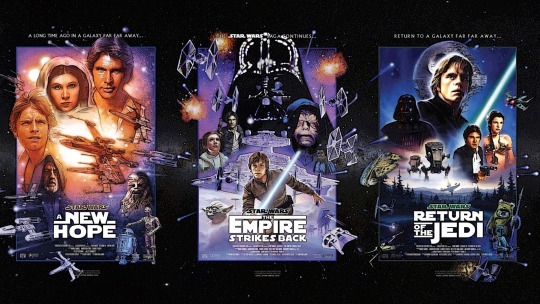
Star Wars IV: A New Hope (1977) -
Definitely the most successful film (heck, one of the most successful films of all time) that made almost a billion dollars at the box office worldwide...in the 80s. Amazing. The story mimics the hero's journey as described by Joseph Campbell, giving it basically the most satisfying story imaginable. Nobody except for friend of George Lucas, Steven Spielberg, thought it would be as successful as it was. This kind of popularity meant there was going to be some sequels and, since George Lucas was the man behind the whole thing, only one man was about to get tasked with future success.
Star Wars Holiday Special (1978) -
This was a TV movie that was made to cash in on the massive popularity of the first movie while the second one was in production. It is terrible. I generally try to hold back judgement and point out subjective opinions, but I think I can say that this made-for-TV movie is objectively bad. It is the equivalent of a variety show, a format which was popular at the time, and it was awful. It is widely considered to be one of the worst visual productions of all time. Just to give a hint of its awfulness, the movie follows the adventures of Chewbacca's Wookie family and they only speak in growls with no interpretation or subtitles. Laughably awful.
The Empire Strikes Back (1980) -
Arguably the best of the films as far as story and plot, this film was actually directed by Irvin Kershner with a George Lucas story adapted to the screen by Lawrence Kasdan. This film is legitimately fantastic and not just new and fun. It is so well written and directed with the famous reveal between Luke and Darth Vader. It also is incredibly downbeat at the end that perfectly sets up the next film. I personally think this is the best example of fine film in the franchise, although it doesn't have as much big action and no giant space laser. Well worth watching and makes the third film a must see.
Return of the Jedi (1983) -
Well, not as good as the first two, but still pretty darn good. This film introduced the Ewoks and the Endor moon battle. Many fans thought that the introduction of living teddy bears was a mistake that distract from the story. What really made the film, apparently, was the whole sequence at the beginning that takes place at Jabba the Hut's palace and involves Princess Leia in a metal bikini. We also find out that Luke and Leia are twins, so that kiss in the second film suddenly becomes kind of awkward. This becomes kind of a theme from here on out: should we disavow canon or put in throwaway lines and scenes to cover things that were mentioned in previous movies. It plagues the prequels.
The Ewok Adventure (1984) -
I get a lot of garbage about it, but I love these movies because I grew up with them. They are not that great and the copy that I saw over and over had ads from the early 80s throughout. Heavy nostalgia. Also, some of the Ewoks were played by established actors from what is now called Episode VI, Warwick Davis as Wicket and Tony Cox as Widdle. It was a lot of fun, but definitely a higher budgeted TV movie. It did become so successful that it got a theater release as Caravan of Courage: An Ewok Adventure. This naming style stuck around for the spin off films that were made in the late 2010s.
Ewoks: The Battle for Endor (1985) -
Hot dang, they made a second one with Wilford Brimley! Both of the Ewok films were thought up by George Lucas and sold to ABC. Both films were also given special Emmy awards for special effects. I can't fault either Ewok film as far as visuals since both got the ILM treatment. I have stated that I liked both of these movies more than some of the prequels, and I stand by that.
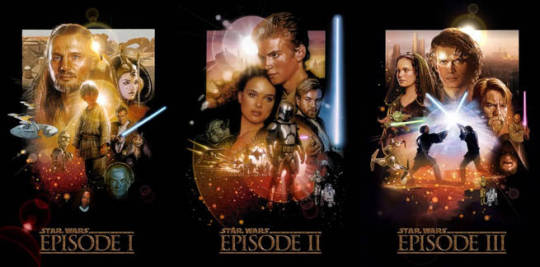
The Phantom Menace (1999) -
The next three films followed the first three episodes in the Star Wars saga and are now generally known as the prequels. They are also pretty widely hated. One reason for that was the introduction of young Anikan Skywalker (eventual Darth Vader) and his growing attachment to Lord Palpatine (Darth Sidious). The problem with the prequels is that it was a path leading to a result that had been established over 20 years ago in the first film. They also introduced a character named Jar-Jar Binks who was just awful. There was a great pod racing scene and an epic Sith vs. Jedi battle that really were the highlights of the film. The music was also pretty epic, but the film was otherwise not that great. It was completely made under the helm of George Lucas and fans were suddenly starting to wonder if he was the genius they had thought him to be. What I consider to be the best YouTube deep dive movie review of all time, a group called Red Letter Media made a seven part review that explains why the movie was such a problem. You can watch the first part and it will auto load all seven here:
(1) Star Wars: The Phantom Menace Review (Part 1 of 7) - YouTube
Attack of the Clones (2002) -
Alright, here is where things really start to go down hill. There is a fine actor by the name of Hayden Christiansen that is just awful in this film. He is given nothing to do for the most part. He is supposed to be this amazing Jedi general, but he spends most of his time walking around speaking in a very monotone voice. He does have some fun piloting scenes, but he is written as such a whiny brat. There are two epic battles (the coliseum and Dooku vs. Yoda) and we get to see a bounty hunter in action. It does seem like a lot of fan service glued together by boring politics and horrifically bad acting.
Revenge of the Sith (2005) -
This is widely considered the worst of the prequel movies and generally laughable at some points. There is supposed to be an epic lava battle at the end, but it is just a bunch of screaming about a failed bromance. We get to see the end of the characters in the prequel and set up the original movies...that were now almost 30 years old. It was unsatisfying and not even slightly worth the wait. It was at this time that George Lucas said that there would never be a seventh episode that would follow the original trilogy.
Star Wars: The Clone Wars (2008) -
There was a very compelling series of Star Wars shorts in 2003 made by Genndy Tartakovsky that did very well. George Lucas saw this and decided that a lot of the most interesting Star Wars events had occurred during the time between the prequels and the original series. Lucasfilm put out an animated movie to test the waters and it was so successful that 7 seasons of great animated adventures were made to show the epic battles that were supposed to take place between the second and third episode. I honestly believe that this was the very best space action of the entire franchise.
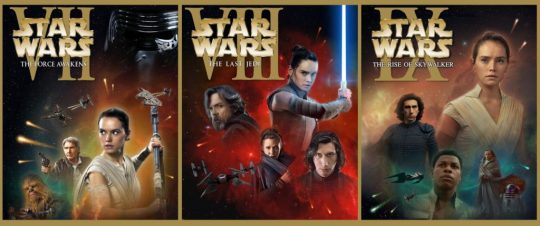
The Force Awakens (2015) -
George Lucas sold the Star Wars franchise over to Disney and fans got a new movie that was never supposed to happen. Once Disney came on board, the brand became much more prolific. Until the pandemic, there were plans to put out a Star Wars movie every year for a decade. The first was episode seven and was made by J.J. Abrams. It was similar to the first film (episode IV) in so many ways that fans started to think it was just a remake. It even had a lot of the characters from the original trilogy. It was much better received by fans following the prequels and introduced a storyline that was not already spoiled by previous movies. There was a lot of unnecessary fan service for those who loved the original trilogy. This makes since because it involved Lawrence Kasdan, who helped with the screenplay for episode five and six from the original trilogy.
Rogue One: A Star Wars Story (2016) -
A full big budget release of a Star Wars movie that wasn't one of the episodes was an interesting idea. It was an entire movie to explain a throwaway line from the original 1977 movie. I lot of people died to get some plans for the big weapon in the first film and people wanted to know exactly how that happened. Actually they didn't. But Disney thought it was a good idea and it seemed like it would make a lot of money (it did). It gave the producers a chance to make a movie with new characters and only mentions of the famous story (this was important because the other actors where making the next episode).
The Last Jedi (2017) -
This was an interesting change of pace from the rest of the films because it seemed to drop the idea of the "chosen one" and say that anyone could be a Jedi. It is basically one giant escape story and is closer to Mad Max in space than it is to the other Star Wars films. It was given in full by Disney to Rian Johnson and it shows. This was the first episode film that had nothing in common with any of the production group from the original trilogy. No Kasdan, no Kirschner, no Lucas, all Disney. It was not very well received.
Solo: A Star Wars Story (2018) -
The worst performing of any of the Star Wars live action feature length films, this was the story of Han Solo. That's it. There is not a lot of history about the character and he is so cool, fans needed to have a stand alone movie about his youth. That's a lie, Disney wanted a movie to come out between episode eight and nine. This was the best that the suits could come up with and it definitely made money, but it is lame.
The Rise of Skywalker (2019) -
Well, the movie completely helmed by Rian Johnson was not popular enough so there was a total retcon situation and this film basically picked up where episode seven left off. It was the same team from episode seven (since that film was so much more popular) and they made a final film that wraps up with a bow. Sort of. There was definitely room in the film world for more Star Wars movies to be made (it is owned by Disney) and I really don't believe it is finished as a franchise.
----------------------------------------------------------------------------
Just in case there are people who were nervous that this was the end of the franchise, there is currently a stand alone film called Rogue Squadron that is supposed to come out in 2023. Thank goodness. There was also the popular Mandalorian series on Disney +. But the franchise has been making huge films for almost 45 years now, so maybe it is time to stop. We have the MCU that has made almost twice as much money as the Star Wars universe, so most movie goers have picked their setting that they want to see. Maybe there could be a crossover (I am kidding, please no) and it would be the most watched film of all time.
17 notes
·
View notes
Link
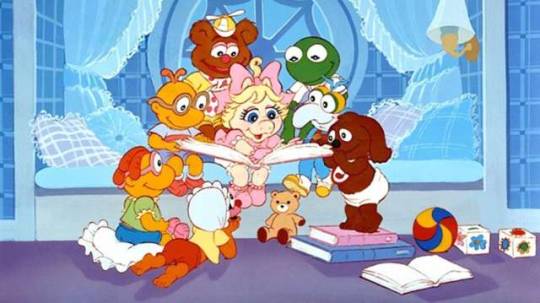
In the '80s and '90s, a lot of things were turned into cartoons. We saw a long list of animated shows based on live-action movies and more than a few that existed simply to sell toys. One interesting subgenre you might not remember, though, is when an animated series would age down an established set of fictional characters. All of a sudden, characters you were used to seeing as adults were portrayed as children on another show.
It happened more often than you may think and, honestly, some of the properties that did this to squeeze a little extra money out of their intellectual property may surprise you. At the end of the day, they all had something that made them entertaining enough to stick to the back of our minds.
Let's jump in the time machine and revisit 18 of the absolute best animated shows that age-flipped characters you knew and love--and maybe a couple you were downright terrified of. Also, make sure to check out our list of movies that were based on beloved cartoons. He-Man, eat your heart out.
1. The Tom and Jerry Kids Show
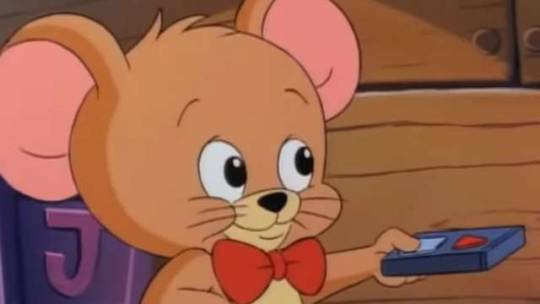
It's not that Tom and Jerry Kids was a bad show, it was actually pretty good. However, the most memorable thing about it is its fantastic theme song. The series also included a kid version of Droopy Dog, in addition to little Tom and Jerry.
2. Muppet Babies

This is easily the most beloved and iconic example of this trend. Jim Henson's Muppets were portrayed as babies when they became a cartoon--complete with onesies, baby talk, and a parental figure named Nanny that was only ever shown from the legs down. Muppet Babies is hands-down one of the best cartoons of the 1980s. What's more, the recent reboot on Disney Channel is also quite fun, even if it doesn't cast tiny versions of your favorite Muppets in movie franchises like Star Wars and Indiana Jones.
3. A Pup Named Scooby-Doo
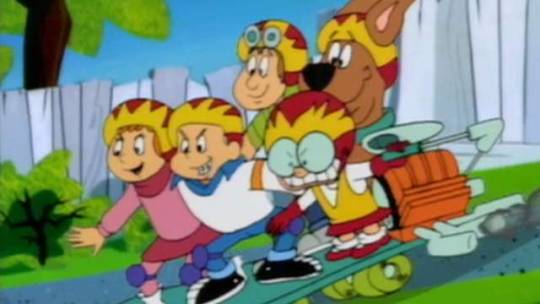
This was another show with a very memorable theme, though it's a confusing one. A Pup Named Scooby-Doo first debuted in 1988, and yet its theme sounds like a doo-wop song from the '50s. Regardless, this show is a blast as a young Scooby gang hunts monsters and solves mysteries, and of course, feeds the titular dog Scooby Snacks to keep him motivated.
4. Flintstone Kids
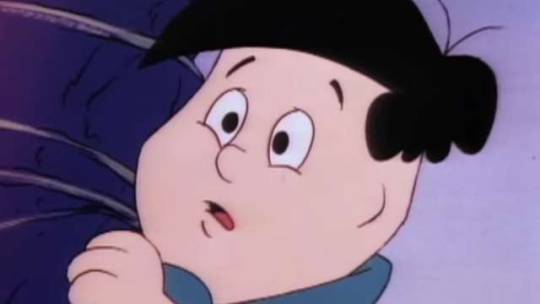
Flintstone Kids was good, but what makes this entry on the list special is the show-within-the-show. Captain Caveman and Son were shorts that aired as part of Flintstone Kids. Originally, Captain Caveman was a character that debuted in the 1977 animated series Captain Caveman and the Teen Angels. On Flintstone Kids, he teamed with his son Cavey Jr. to fight the forces of evil. As for the little Flintstone gang themselves, that part of the show was also very fun, though you might remember it most for the public service announcements that aired during the episodes.
5. Tiny Toon Adventures
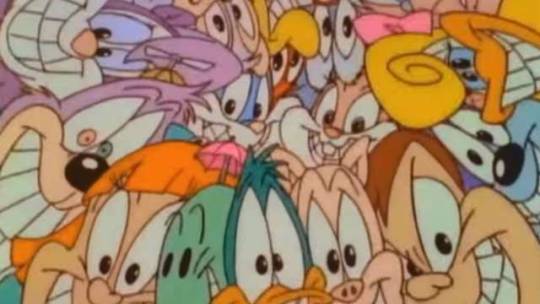
This one is, admittedly, a bit of a cheat. The kids on Tiny Toons weren't actually the kid versions of Bugs, Daffy, Taz, and the rest of the gang. It doesn't get much closer, though. Baby and Buster were clearly a younger take on the different sides of Bugs Bunny, while Plucky Duck has Daffy's temper, Dizzy was the spitting image of Taz, and Hampton was so close to Porky Pig it was scary. What's more, sometimes the classic Looney Tunes characters made appearances on Tiny Toons, seeing them team up with their younger proteges.
6. James Bond Jr.
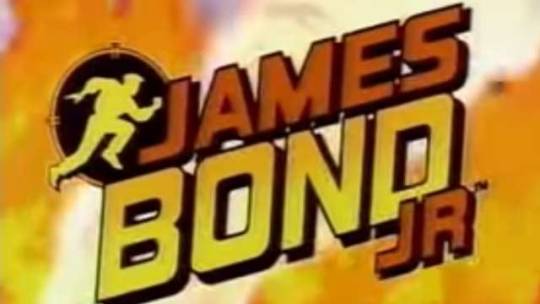
This is another one that sort of works, but only if you stretch the premise a bit. James Bond Jr. was the nephew of James Bond and a spy-in-training and, along with his prep school friends, was fighting the forces of evil just like his infamous uncle. What you may not know, though, is James Bond Jr. has his own novels. The Adventures of James Bond Junior 003½ was first released in 1967, written by an author under the pseudonym R. D. Mascott. Interestingly, the actual author of the book has never been officially revealed, though several names have been theorized.
7. Baby Looney Tunes
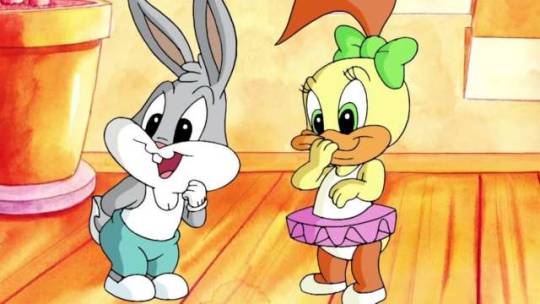
First debuting in 2001, this is a much newer series than Tiny Toons. What's more, it actually delivers what you might have been looking for in that show--this is the actual Looney Tunes characters as babies, in case the title of the series didn't hint at it enough. This series essentially Muppet Babies, but with Bugs Bunny and friends. What's not to love?
8. Yo Yogi!
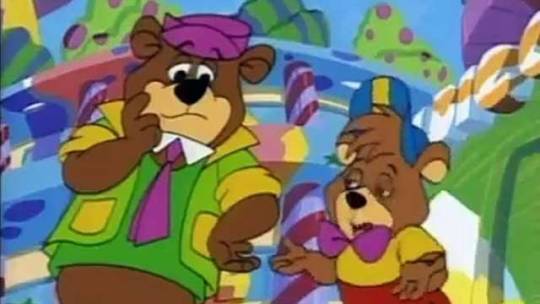
If you've actually heard of this one, congratulations. You're as nerdy as we are. Yo Yogi! debuted in 1991 and only lasted for 12 episodes. It was the most over-the-top version of the '90s you could expect, complete with a neon-colored makeover of Yogi's clothes. The series casts the bear and his pals--Boo-Boo, Snagglepuss, Huckleberry Hound, Cindy Bear--as 14-year-old crime fighters. What else would you expect these animated teen animals to be?
9. Jungle Cubs
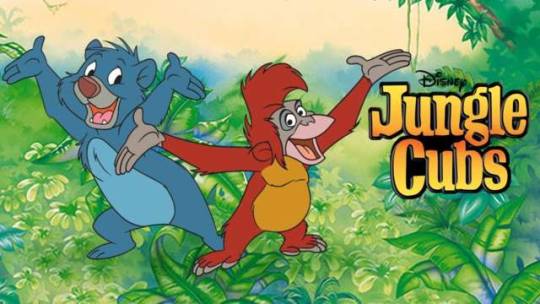
Yes, Disney's The Jungle Book for the kid treatment, even though the main character in the movie is already a kid. This version doesn't feature Mowgli at all. Instead, the animals are all kids, living it up in the jungle. They aren't crime fighters of ghostbusters or anything like that. Instead, they're just friends hanging out. Oh, and we have to mention the theme song, a hip-hop version of "The Bare Necessities."
10. Clifford's Puppy Days
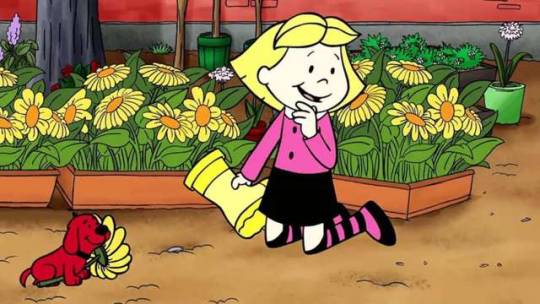
If you were a kid in the early-aughts, you might remember Clifford's Puppy Days. Before he was Clifford the Big Red Dog, he was Clifford the normal-sized puppy that wasn't a menace to keep and maintain.
11. The New Archies
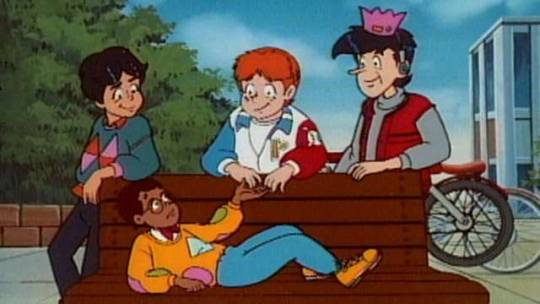
Before Riverdale turned Archie and his friends into a Twin Peeks-flavored murder party of teenage angst, The New Archies made them little kids. The gang is in junior high and, well, not much else has changed. It lasted 13 episodes and was still the incredibly wholesome Archie Comics you knew back then before it went full-CW.
12. Sabrina: The Animated Series
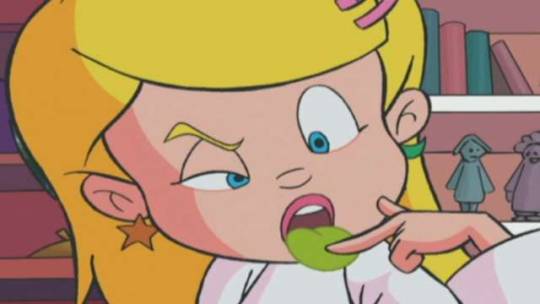
The animated Sabrina series was a spin-off of the live-action version starring Melissa Joan Hart and featured the titular teen as a 12-year-old. She was still learning her magical ways and getting into all sorts of trouble with her spells. In this series, Sabrina is voiced by Hart's little sister, Emily Hart. However, the original Sabrina does play a role, voicing Sabrina's aunts Hilda and Zelda.
13. Camp WWE
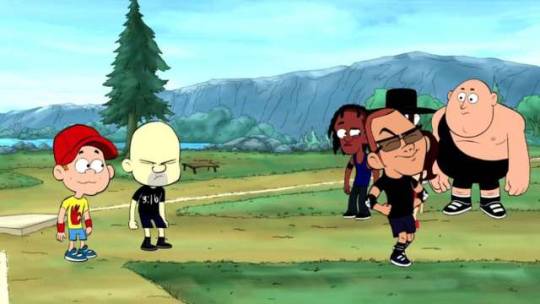
What if WWE did its own take on South Park? That's Camp WWE, an animated series that's definitely meant for adults. All of your favorite WWE superstars, including "Stone Cold" Steve Austin, The Rock, and The Undertaker, are little kids at a summer camp run by Vince McMahon, his teen daughter Stephania, and her boyfriend Triple H? That's all you need to know about WWE. It pokes fun at WWE and professional wrestling as a whole, is filled with more adult language than you'd find on Raw or Smackdown, and it actually one of the most entertaining WWE Network originals.
14. Ewoks
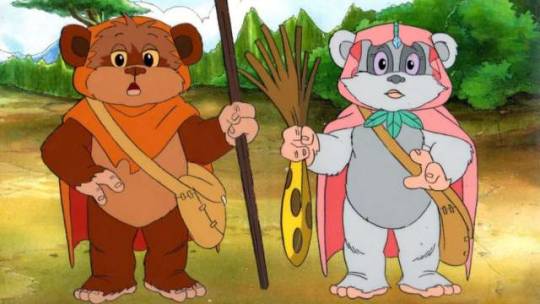
Yes, this is real. There's honestly no telling how old the Ewoks are in Return of the Jedi. But who cares? In this Star Wars animated series, viewers follow a younger version of Wicket and his friends before the events of A New Hope and, for some reason, they speak English now. Originally, this series aired with the half-hour show Droids for The Ewoks and Droids Adventure Hour, otherwise known as the coolest one-hour block of TV you'll ever experience.
15. Iron Man: Armored Adventures
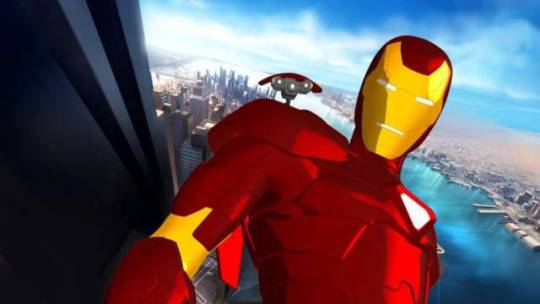
This is the most recent series on the list, but need to be pointed out. Iron Man: Armored Adventures followed Tony Stark as a teen Iron Man, alongside a similarly-aged Pepper Potts and Rhodey. If you thought Stark might have less of an ego as a teenager, guess again. Still, this take on Iron Man was entertaining and it managed to introduce a long list of popular Marvel characters--from Black Panther to MODOK.
16. The Mini-Monsters
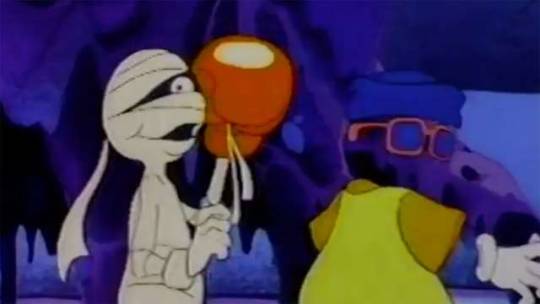
So, The Mini-Monsters wasn't a show. It was, however, a segment within the animated series The Comic Strip. The segment featured the children of the classic Universal monsters, including Frankenstein's son Franky and the Invisible Man's son Blanko. It's utterly ridiculous, with a premise of a pair of siblings (one of which is voiced by Seth Green) being sent to a summer camp filled with the children of actual horror villains for a year. This is the oddest entry on the list, but one of the best.
17. The Pebbles and Bamm-Bamm Show

While this is a list of cartoons that turned adult characters into children, it didn't always work out that way. In some cases, the process goes backward, and this is a perfect example of that. On The Flintstones, Pebbles and Bamm-Bamm were the kids of Fred and Barney, respectively. That series ended in 1966, though, with The Pebbles and Bamm-Bamm Show following in 1971. In that series, the two titular characters were teenagers, attending high school together and starting a band. What was the band called, you ask? The Bedrock Rockers. This sequel series only lasted 16 episodes, but it remains a cool idea that most cartoons won't dare touch. Bart Simpson has been in elementary school for three decades, and chances are that won't be changing anytime soon.
18. All Grown Up
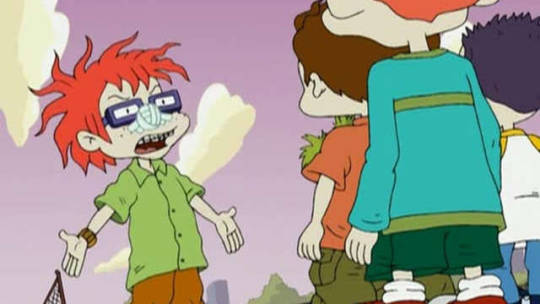
This series also aged up popular baby characters. All Grown Up revisited the world of Rugrats. This time, though, Tommy Pickles and his friends were preteens and had more fleshed out personalities. It lasted five seasons on Nickelodeon, airing between 2003 and 2008.
from GameSpot - All Content https://ift.tt/2ZG6o5a
5 notes
·
View notes
Text
rewatch: “return of the jedi” [1983]
The sense of texture to the worlds and people and use of practical effects really makes it feel lived in and specific, even with the crappy CGI stuff Lucas added later! I can see why the grit, texture, and mythological storytelling appealed to so many people, even though I was a Trekkie as a kid. They’re very distinct worldviews: one based in the modern myth of progress and the other reaching for dramas of family and psychology that go back as far as recorded history and probably further
Leia is treated with so much more kindness and respect than female characters were by default in 1970s-80s movies. Sure, there are limits, but this is really on the higher end of representation at the time. Even with the slave costume thing! As Carrie said, she strangles Jabba to death. And btw just in general kudos to Carrie, who is captivating whenever she’s on screen <3
There’s a lot of ways to interpret it, but as someone who’s studied the post-WWII period it strikes me as such a cri de coeur of a Boomer son with a Greatest Generation father. Dad is frightening, modernist, distant, broken but keeping it all inside. Beneath technology and control. Did I mention kind of frightening? And he wants you to turn yourself into a weapon for The Man too, to fight the same evil imperialistic battles. But you just want to hang out and be chill and connect with your own soul/the universe and let other people do their thing too
Moving away from political metaphor, the idea of accepting the darkness in yourself and your own family legacy (even if your close kin are amazing, if you’re part of the human family, you’re part of a family that has committed murder, cruelty, etc and have to find a way to understand that) and finding the strength to move forward in light and love through your recognition of that is really really cool
Luke as a christlike figure willing to suffer physical torments and risk himself for his father’s salvation is intense and unique. Breaks a lot of rules of traditional “masculine” heroism where you bend the world to your force and pummel it into submission. ALSO I’d like to note that he achieves compassionate love not by emptying himself of feelings (as I feel like the Jedi Order came to over-emphasize)... the fear and anger are still there, but he chooses to have faith and that proves stronger than his fear and anger. Even though it’s a battle! And I LOVE that it’s a battle. I never really felt his journey as a young person and I know a ton of people have a problem with TLJ... but I finally love the guy? I love him as someone who has always struggled and who has very dark times and yet manages to reclaim his faith and be a beacon of hope... He’s kind of a Marty Stu, especially early on. But the Boomer son stuff and nonviolent conflict resolution is really special and always has been. I feel like his complete journey emphasized that even more in a way that really works for me. Faith and love didn’t just come easy for him. Life is a perpetual struggle and sometimes we fall but we can rise again too. The light is always there for you.
Mark Hamill is much hotter to me than Harrison Ford sorry not sorry
Speaking of TLJ, people climb all over Rian Johnson’s ass for the pacing but at even the slowest moments of Canto Bight there were, like, three levels the story was operating on and there’s a ton of screen time here that is just empty action or weirdly paced. I actually like that; the more chill pacing at times, with characters just, like, wanting to hang out with their new Ewok friends works for the story. Though I could have done without the singing/dancing routine by the sex slaves (??)/sex workers at Jabba’s place
3 notes
·
View notes
Photo
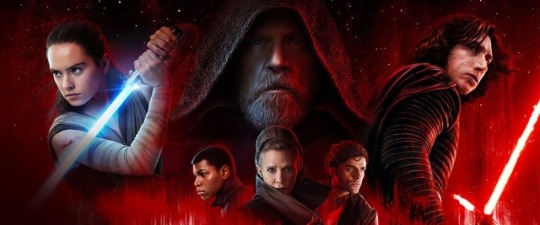
Star Wars, The Generations
Time to talk about “Star Wars: The Last Jedi.”
(I’m going to assume that by now, Sunday of opening weekend, you’ve seen the movie, because, if you haven’t, a: what’s wrong with you? and b: why are you reading my blog?)
In a terrific piece for Vulture.com, @abrahamjoseph discusses “Last Jedi” as the first truly populist Star Wars movie. [http://www.vulture.com/2017/12/rey-parents-star-wars-last-jedi-populism.html] I fully agree with Abraham’s reading, but I’d add a further observation: it’s the first story in the Skywalker saga to honestly address tensions between generations– in particular, tensions between the Baby Boom generation and the generations that have come to adulthood since its rise, Generation X, and the Millennials.
George Lucas was the avatar of the Boom generation, and his obsessions, fantasies, political beliefs, life choices, myopias, and sense of destined self-importance are all hallmarks of the generation he embodied and spoke to.
Rian Johnson is a true representative of Generation X, a talented and gifted man whose singular voice has been muffled by the presence of aging giants taking up creative space around him. If Johnson had arrived on the scene in 1972 with a film as smart and accomplished as his debut “Brick,” I could easily imagine him having been embraced as were Lucas or Spielberg or Friedkin, and given the same opportunities they received for far less accomplished debuts. (“THX-1138,” for all its technical achievements, suffers from an intellectual coldness of execution; no one ever has made a case for “Sugarland Express” as other than pleasantly forgettable; and the less said about “The Night They Raided Minsky’s,” the better.) But Johnson, and his fellow Generation-X directors, men and women, came of age as young filmmakers in the early 2000s– an age dominated by Baby Boom filmmakers like Spielberg, Lucas, Cameron, et al. Johnson’s opportunities (and theirs) were diminished. To contrast, in the ten years starting with “Sugarland,” Spielberg made eight films; Johnson made three. Not everyone is a Spielberg, of course, but it’s a fact the Baby Boom generation sucked up most available funding for filmmaking between the mid-1970s and the late 2000s. Talented filmmakers like Rian Johnson (and fellow Generation-X director Patty Jenkins) paid their bills and honed their skills directing television, where they contributed (with other shut-out Generation-X creatives) to an explosion of remarkable narrative experimentation unequalled on the big screen itself.
Ironically, the director of the first new Star Wars film, J.J. Abrams, seems to have more in common with the aesthetic, emotional, and political concerns of the Boomer generation than his fellow Gen-Xers, possibly because, at age 51, his childhood in the late Sixties and early Seventies was surrounded by the Boomers’ cultural triumph. Rian Johnson and Patty Jenkins grew up as the Boomers’ idealized liberal world collapsed into Reaganesque cultural exhaustion.
It’s this ‘80s collapse of the Boomer’s liberal dream into conservative exhaustion that informs Rian Johnson’s aesthetic and narrative approach to “The Last Jedi.”
Episode VIII, unlike Episode VII, recognizes the Boomer fantasy of cultural and political renewal through rebellion and the power of elitist “destiny” actually ended in disappointment, failure, and despair. The Baby Boomer Rebels who fought an Evil Empire that invaded the jungles of Endor and burned Ewok villages (an easy Boomer metaphor for U.S. miltary action in Vietnam) ultimately collapsed into a corrupt generation of disillusioned idealists. Those despairing former idealists then empowered the rise of a new militarism, unopposed by an out-of-touch political establishment so distant from average citizens its destruction is a barely noticeable flicker in the sky.
Rian Johnson deconstructs the myths of the Baby Boom generation that adopted Star Wars as its foundational fiction. The rebellion against the Empire produced not a healthy new Republic but a remote and disconnected government with no productive impact on the lives of its poorest, weakest citizens (Rey and Finn). The heroes of the Rebellion either retreated when confronted by failure to fulfill their “destiny” (Luke), turned back to their previous lack of convictions (Han), or soldiered on in an attempt to reclaim old ideals in the face of diminishing odds (Leia). Thirty years after the death of Emperor Palpatine nothing really has changed in that Galaxy long ago and far away. It’s a bleak recognition the 1960s Boomer Revolution was an utter political failure (but not a cultural failure, since we live in a culture that pretends to realize Boomer ideals).
To be fair, Abrams nods toward these notions in “Force Awakens” but undercuts their impact by hewing closely to the undergirding mythic structure of the original Boomer-fantasy “Star Wars.” The idea that destiny and mysticism will produce ultimate victory is a Boomer trope thoroughly embraced by “Force Awakens” and totally dismantled by “Last Jedi.” At every turn, in this latest film, Rian brings to bear the judgmental eye of a somewhat cynical Generation-Xer– surprisingly, and pointedly, not just upon the self-serving fantasies of Baby Boomers, but on the inexperienced surety of the generation following his own, the Millennials.
Just as Luke, Han, and Leia are revealed as heroes with feet made substantially of clay (Leia comes off best of the three, but again, notably, is out of action when crucial decisions must be made), the four featured Millennials in the story are also subjected to Rian’s cool Gen-X appraisal. Kylo, Rey, Finn, and Rose embody familiar traits of today’s Millennial generation.
With Rey, we are presented with the idealistic Millennial archtype– a passionate young woman who embraces the professed beliefs of an earlier idealistic generation, even when she doesn’t quite understand them. (The Force is a “power that helps you move things.”) She’s hopeful, convinced the old ways can restore justice, even though those old ways failed before. She hasn’t come into her own yet. She still seeks strength and validation from others. She wants to be rescued, but slowly, over the course of the story, realizes she must do the rescuing. Her idealism is as yet untempered by experience, but the disappointments she experiences both with Luke and Kylo finally make her stronger than ever.
With Finn, we find a Millennial beaten into submission by a system that appears impossible to resist. His first instinct is always to escape any way he can– but opposing that instinct, and empowering his initial rejection of the First Order’s ruthless militarism, is a strong sense of empathy. Instinct tells him to run; empathy makes him run toward those in need. The first time he sees Rey, in “Force Awakens,” he thinks she’s in danger and impulsively runs toward her. His first word on waking in “Last Jedi” is “Rey!” Even when he’s about to flee the doomed Resistance fleet, he’s combined his instinct to run with an instinct to protect. Like Rey, at the beginning of “Last Jedi” he isn’t who he will become by the end. He’s conflicted, uncertain, immature, and inexperienced. He learns a lot hanging out with Rose.
Rose, Finn’s new friend, is the most emotionally developed and self-aware Millennial in this group, possibly because she’s had the benefit of a close relationship with an admired older sister. Rose knows who she is and what she believes. She has enough experience in life to understand the structural injustice that underpins the Galactic order, and is dealing with the kind of personal tragedy that gives one perspective. Of all the Millennials in “Last Jedi” she changes the least during the story because she’s already who she will always be: a capable, brave, empowered woman who knows her place in this world– a worker and doer, not a dreamer.
And Kylo. Kylo Ren is the most obviously political figure in “Last Jedi,” the embodiment of alt-right Millennial nihilism. Feeling abandoned by his late-life, self-involved Boomer parents, attacked with suspicion by the substitute parent who became terrified by his potential, embraced and manipulated by a cynical monster, another substitute father– Kylo Ren is Millennial rage incarnate. He embraces anonymity behind a mask while striking out in unbridled anger against all who oppose him (sub-redit, anyone?) and yet, pathetically, yearns for the approval of a woman he scorns. If Rey is the light side of idealism, the promise of hope, Kylo is the dark side of idealism thwarted, the nihilism of despair. Rage is the expression of Kylo’s hopelessness, not its source.
This is a fundamental difference between Lucas’s vision of the dark side of the Force and Johnson’s. To Lucas, the eternal Boomer idealist, the dark side was always incomprehensible– the explanation he provides for Anakin Skywalker’s turn to the dark side in the prequels never feels right. (Tellingly, in the original trilogy, Vader’s origin is never explained.) Because Lucas himself wasn’t thwarted in pursuit of a dream, never faced exclusion from the idealistic fantasies of the Boomer generation, never despaired from lack of hope– he couldn’t articulate what gives the dark side of the Force its bleak alure. “Fear” and “anger” are meaninglessly abstract without personal context. Rey and Finn are often angry and fearful, but is there ever a real question they’ll despair? Even in their darkest moments they cling to hope. Why does Anakin succumb to the dark side? Lucas doesn’t really know, and the manner in which he structures Anakin’s story provides easy answers but not convincing ones.
Rian Johnson, however, the Gen-X filmmaker initially thwarted pursuing a career must understand the seductive lure of despair. He can empathize with Ben Solo, and make his embrace of the dark side comprehensible, in a way Lucas could not with Anakin Skywalker. (Or J.J. Abrams, who portrayed Kylo’s dark side persona as a combination of twisted ancestor-worship and petty father resentment.) Johnson’s approach to Kylo Ren is tempered with sadness and maturity. It’s the sighing judgment of a Gen-X middle manager watching a potentially valuable younger employee destroy himself. Such a waste, but so understandable.
This aspect of the complicated Generation-X perspective brings me to the two Gen-X characters in “Last Jedi,” who, fittingly for Gen-X, may seem less important compared to the colorful and dominant Boomer and Millennial stars, but prove to be the heart and soul of the moral argument at the core of this great movie: Poe Dameron and Vice-Admiral Holdo.
On the surface, Poe Dameron is very much a Han Solo knockoff– the cocky, smart-talking pilot who achieves the impossible with style. In Episode VII, by Boomer-influenced J.J. Abrams, that’s all he was, and apparently, until Oscar Isaac made a case for continuing the character, he wasn’t even intended as more than a one-off. With Rian Johnson at the helm, however, Poe becomes a crucial figure whose character arc encapsulates the lessons Johnson seeks to impart with this film: victory isn’t achieved by miracles, it isn’t only a product of self-sacrificing heroism, it’s hard won, complicated by tough choices, and sometimes what needs to be sacrificed isn’t a life– but the notion of heroism itself. Poe begins the movie believing victory is possible only if you’ll dare to pay the price; by the end, he understands “victory” isn’t victory if the price is life itself. That’s an incredible statement for an American blockbuster to make (a theme underscored by Rose preventing Finn from making the ultimate sacrifice himself). In 2017, after 16 years of America fighting an unending war with no “victory” in sight, it’s as political a statement as the original Star Wars metaphor of Empire trampling the jungles of Vietnam/Endor.
But there’s another side to the Generation-X cynism about war’s futility: , the fact that, despite cynicism, and awareness the battle might not be worth the price, Gen-X is still willing to do what needs to be done. Knowing hope may be unjustified, the Gen-Xer still hopes. This conflict between cynicism and hope is at the heart of the Generation-X dilemma, and at the heart of “Last Jedi.” That conflict, with its ultimate decision in favor of hope, is given form and power in the noble sacrifice of Vice Admiral Holdo.
Vice Admiral Holdo is the older, wiser, unimpressed but still hopeful Generation-X leader who understands the risks of action and so refuses to act recklessly. She didn’t start the war– the Boomers did. She inherited it. She wants to minimize damage and salvage what she can. She knows, when the bill comes due, she’s the one who must pay it– and she does, without hesitation, because that’s what the men and women of her generation always do. She cleans up the mess Leia and the Resistance leaders left behind. She guides the retreat. She does what must be done. Practical and blunt, she has no time for Poe’s heroic bullshit. Because she knows the Resistance may never achieve what the Rebellion tried to accomplish, she understands despair, but she’s too busy dealing with the problems before her to indulge it– or to hope. She does what’s necessary. It’s what Generation-Xers always do. Even if it means flying a cruiser at light speed into a First Order fleet.
Great movies reflect an era through the eyes of artists who embody that era. George Lucas embodied the era of Baby Boom “destiny” and self-conceit (“I’m the most important individual in the Galaxy because of my mystical understanding of reality”). Rian Johnson embodies our era of diminished heroism, cynicism and near despair– tempered by the hope, if we can but learn from our heroes’ mistakes, that somehow, some way, some day, we may yet restore balance to the Force.
567 notes
·
View notes
Text
No one told me about the TWO (2) made for TV live-action EWOK MOVIES in the 80s. This revelation is on par to finding out about the Star Wars Holiday Special for the first time.
Like....

...how the fuck??

does this exist???
#THEY LOOK TERRIBLE AND I LOVE THEM ALREADY#star wars#caravan of courage#ewok adventure#swnews#ewoks: the battle for endor#DID YOU KNOW ABOUT THESE?#ashie makes a post
319 notes
·
View notes
Text
Star Wars Clone Wars: Which Parts of the Tartakovsky Series Can Still Be Canon?
https://ift.tt/eA8V8J
Party like it’s 2003! On April 2, Disney+ will begin streaming the Genndy Tartakovsky version of Clone Wars, which means, for certain generations of Star Wars fans, a slightly alternate version of the iconic storyline will be available to watch on the app for the first time. Along with Clone Wars, Disney+ is also dropping two of the made-for-TV Ewok movies, and the animated ‘80s TV series Ewoks. And while all of that Ewok action certainly makes us nostalgic, let’s get serious: the Tartakovsky Clone Wars is the real deal.
Besides being the first animated series set during the Clone Wars, the 2003 microseries is best known for introducing fan-favorite characters such as Asajj Ventress, General Grievous, and Durge. Most importantly, in the first few years following the end of the Prequel Trilogy, Tartakovsky’s series was the definitive story of what happened during the Clone Wars.
That’s until the arrival of The Clone Wars (differentiated by a “The” in the title). This second animated series ran from 2008 to 2020 and featured huge moments of its own: it introduced Anakin Skywalker’s Jedi padawan Ahsoka Tano, brought Darth Maul back from the dead, and fleshed out the history of the Mandalorians.
Stream your Star Wars favorites right here!
The 2003 microseries and 2008 series were both considered canon early on, but when Disney bought Lucasfilm in 2012 and retconned the Star Wars timeline, the studio erased the classic Legends continuity and established The Clone Wars as the true, canon version of events. That means the stories in Tartakovsky’s Clone Wars never happened in the current Disney canon.
But that may be about to change. Along with Clone Wars‘ arrival on Disney+, Disney has also announced the return of shape-shifting bounty hunter Durge to Star Wars canon. His appearance in the upcoming Marvel Comics crossover event War of the Bounty Hunters could pave the way for the return of other parts of Tartakovsky’s classic Clone Wars series. Here’s how all of this can work:
Tartakovsky’s Clone Wars Mostly Still Fits into the Star Wars Timeline
Up until very recently, you could have reconciled the first Clone Wars with The Clone Wars fairly easily. In a hypothetical headcanon, you could have decided that seasons 1 and 2 of Clone Wars happened before the 2008 The Clone Wars movie and the introduction of Ahsoka.
After Anakin gets Ahsoka as his new apprentice/partner, you’d then watch The Clone Wars seasons 1 through 6. Ahsoka leaves the Jedi Order in season 5, which would explain in your headcanon why she’s not in Tartakovsky’s series at all. After the events of season 6 of The Clone Wars, you could then insert Clone Wars season 3 into the timeline, since those 2005 episodes end directly before the events of Revenge of the Sith. (In Tartakovsky’s Clone Wars, we even saw Palpatine get kidnapped by General Grievous on Coruscant.)
So, to recap, before the belated season 7 of The Clone Wars in 2020, you could have just assumed the Clone Wars timeline looked something like this:
Attack of the Clones
Clone Wars (Tartakovsky) Seasons 1-2
The Clone Wars Movie and Main Series Seasons 1-6
Clone Wars (Tartakovsky) Season 3
Revenge of the Sith
There’s just one problem: the events of Clone Wars “Chapter 25,” which were meant to lead right into Revenge, are directly contradicted by The Clone Wars season 7 episode “Old Friends, Not Forgotten.” In the Tartakovsky version, Obi-Wan and Anakin get the call to defend Coruscant after a dangerous mission on the planet Nelvaan, but in The Clone Wars, Anakin is with Ahsoka, planning to go to Mandalore, when he and Obi-Wan are diverted to save Palpatine. That means, if you’re particularly stringent about events lining up perfectly in your headcanon, at least some of Clone Wars couldn’t really exist in the same timeline as The Clone Wars.
Obviously, there are many other little inconsistencies between Clone Wars and The Clone Wars, but this one very specific plot point from the final season of The Clone Wars is the smoking blaster that kills any hope of the Tartakovksy series as a whole being canon. But that doesn’t mean all is lost…
Durge Is Back, So Does His Clone Wars Story Count?
Durge’s upcoming canon debut in June’s Doctor Aphra #11 opens the door for at least some of the events of Clone Wars to return to Star Wars canon.
In Clone Wars “Chapters 2-4,” Obi-Wan (partially clad in clone trooper armor for the first time) battles Separatists on the banking planet of Muunilinst. Obi-Wan’s biggest antagonist in this battle is Durge, a centuries-old bounty hunter, encased in a suit of armor, who has rowdy regenerative powers that make him kind of like the Star Wars version of Wolverine combined with Apocalypse.
Long story short, he’s very hard to kill and this leads to one of the best duels in Tartakovsky’s series. Best of all, since the fight takes places in season 1 of Clone Wars, it could still easily fit back into the canon timeline. Creators wouldn’t even really need to create a new backstory for the character. Since he’s centuries-old, even his Legends history with the ancient Mandalorians and Sith still works within Disney’s framework. You could really just sprinkle all of those details back into the timeline without much puzzle-solving.
What else could the Lucasfilm Story Group easily reincorporate into canon? Again, the entire microseries can’t be reincorporated because of that pesky Clone Wars Season 7 scene but what about that epic moment when Anakin is knighted and his braid is snipped off by Yoda’s lightsaber? That can be canon again, right? What about Asajj Ventress’s duel with Anakin in “Chapter 19?” That should totally count!
Okay, real talk. Durge returning to canon Marvel Comics, and Disney+ streaming Clone Wars, doesn’t suddenly mean more of the microseries is being retconned back into the timeline. Durge is back, sure, but it doesn’t mean Disney will bring any of his Legends storylines with him.
Just look at the way Rebels retconned Grand Admiral Thrawn. In that animated series, Thrawn is 100 percent the same character we remember from the ‘90s Timothy Zahn novels, but he’s in a totally different part of the timeline. The events of Rebels take place up to five years before the Original Trilogy, while the now non-canon, original Thrawn novels took place five years after the OT. That means Disney still has the breathing room to decide whether a new version of the events of the classic Zahn novels ever happened in the current timeline.
The same goes for Durge in the Marvel comics. War of the Bounty Hunters, which is set between The Empire Strikes Back and Return of the Jedi, is nowhere close to the time period of Clone Wars. Same character, totally different decade. Disney could just decide this is a new version of Durge with no connection to the Clone Wars at all.
cnx.cmd.push(function() { cnx({ playerId: "106e33c0-3911-473c-b599-b1426db57530", }).render("0270c398a82f44f49c23c16122516796"); });
Then again, because The Mandalorian name-checked Thrawn in season 2, it’s possible that a revised version of “The Thrawn Trilogy” could still happen in the post-Return of the Jedi (and pre-Force Awakens) timeline in which the Disney+ live-action series is set. This doesn’t mean this is going to happen, but like the headcanon Clone Wars/The Clone Wars timeline, you could easily make it all fit in your mind.
Durge is canon again. That much is certain. The first Clone Wars is streaming on Disney+. That’s happening, too. But will Durge admit to having been at the Battle of Muunilinst in Doctor Aphra #11? Even if he doesn’t, for many of us, it still happened. After all, some canon, especially where Durge is concerned, depends greatly on a certain point of view.
Star Wars: Clone Wars is streaming now on Disney+.
The post Star Wars Clone Wars: Which Parts of the Tartakovsky Series Can Still Be Canon? appeared first on Den of Geek.
from Den of Geek https://ift.tt/3cKysvj
0 notes
Text
IME, the single most interesting thing about THE EMPIRE STRIKES BACK as a movie (rather than simply a Franchise Media Product) is that it serves as a capstone and endpoint for the '70s paranoid conspiracy thriller genre (of which CAPRICORN ONE (q.v.) is one minor example).
The paranoid conspiracy thriller was essentially a response to white liberal disillusionment in the wake of (inter alia) the Vietnam War and Watergate. The driving force of most of the movies in that genre is a sense of outraged betrayal at the exposed cynicism and criminality of liberal institutions; this is a pretty consistent feature across those movies, whatever their individual plot details or areas of focus.
What EMPIRE does in its central Luke/Vader plot is to strip that concept of any specific real-world sociopolitical framework and distill it down to its emotional core: The genocidal, sadistic fascist murderer and torturer Luke's friends have spent the entire movie running from is not the father-killer Luke has wanted to confront and vanquish, but the father himself, twisted almost but not quite beyond recognition. Luke's reaction is the culmination of a decade and a half of accumulated cultural angst, anger, and sour nostalgia, expressed in a single quasi-Oedipal primal scream. As a piece of cinema, it's brilliant: It's raw enough that it makes total, horrifying sense even to quite young kids, and it hones in so precisely on the roots of adult disillusionment that its fundamental childishness still has real dramatic punch.
The problem EMPIRE poses as a Franchise Media Product is that its emotional core is easier to expose than to reconcile. EMPIRE itself doesn't seek to do that; indeed, it's remarkable in how beaten it leaves its heroes, who are hard-pressed just to escape. The third movie, however, struggles with and is eventually defeated by the weight of this same theme. It no longer seeks to defeat the evil father, but to rehabilitate him, which creates an insuperable dramatic problem: It robs the simplistic action resolution (a less interesting reiteration of the climactic scenes of the first movie) of satisfaction, and it asks the viewer to accept that a single act of (obviously selfish!) parental intervention somehow mitigates all of the betrayal and evil that's gone before. There are various reasons the third SW movie doesn't work (the exasperating segues from goopy to saccharine fantasy, all entirely lacking the lived-in feel that the original film had before its various digital retouches; the lazy dismissal of the original romantic triangle; the retreading of too much familiar ground), but even if there had been fewer Muppets and Ewoks, the story is founded on the same kind of cheap and cynical faux-uplift as the Reagan administration during whose deplorable tenure the film was released. EMPIRE was released in 1980, but it's at heart a '70s movie; RETURN OF THE JEDI is a product of the '80s, slick, cynical, and empty.
2 notes
·
View notes
Text
Off the top of my head, there’s
the main nine Star Warses
Rogue One
Solo
at least one live-action made-for-tv movie, something about some kids living with Ewoks?
The Holiday Special
The Mandalorian
Rebels
Clone Wars
The Clone Wars
the 80s Ewoks cartoon
the 80s Droids cartoon
the old Marvel comics
the new Marvel comics
the massive expanded universe of novels
several decades of video games
That’s too many Star Warses. Go have some new ideas.
Taika Waititi better not make a Star Wars. There are enough Star Warses already, I would venture to go so far as too many, and he is supposed to be busy making a TV series out of “Time Bandits”, which there is currently only one of.

7 notes
·
View notes
Text
Operation: Hal Rayle and Maggie Roswell to attend TFNation 2017
Transmission Initiated Transmission ID:00012 TFNation_2017 Operation: Hal Rayle and Maggie Roswell to attend TFNation 2017
We are honoured to announce two very special guests for TFNation 2017 as the husband and wife team of Hal Rayle and Maggie Roswell join UK fans for the very first time, for something a little different!

To Transformers fans, Hal is best known as G1 Snarl – the surly Stegosaurus member of the Dinobots. A character so tough he was actually created to bring his fellow Dinobots in line!
In addition to voicing the coolest set of solar panels to grace a 80’s kids toy, Hal also voiced Shrapnel throughout the G1 series and the 1986 Transformers Animated movie, (not so tough, we admit) the reptilian Skuxxoid race (relatively tough, depending on payments owed) and finally the VERY TOUGH AND VERY MUCH ALIVE Autobot Pipes in Five Faces of Darkness.
Outside of Transformers, Hal's work could be heard in a number of classic 80s and 90s animations, voicing Arzon in Visionaries, Deep Six in Action Force, Prince Kro-Tan in Defenders of the Earth, Lieutenant Commander Steel in Swat Kats and numerous other appearances in shows such as Galaxy High, TMNT and Universal Animation's Back to the Future, in which he clocked up over 65 separate voices alone.
In live-action projects, Hal has leant his voice to many strange creatures including the Predator in Predator2, all the Ghoulies in Ghoulies and, as his first IMDB credit, voicing an Ewok in Caravan of Courage.
Given our attendees are displaying a growing interest in the technicalities behind the mic of voice acting, we couldn't resist the opportunity to bring in someone from the biggest animated series of all time. So it gives us great pleasure in welcoming The Simpsons very own Maggie Roswell to our robotic world.

Maggie has been a part of The Simpsons since the very beginning, voicing regulars Maude Flanders, Helen Lovejoy, Luann Van Houten, and Elizabeth Hoover as well as dozens of supporting and guest characters across more than 175 episodes. Her impact on the show is so great that when she took a temporary leave from the show it resulted in the death of one of those characters!
Beyond Springfield, Maggie’s career is extremely diverse with vocal work for the likes of Mighty Mouse, Darkwing Duck, the feature Fire and Ice and Animaniacs, alongside onscreen performances in shows such as L.A. Law, Remington Steele, Happy Days, Dynasty, Quantum Leap, Mork & Mindy and many more.
That last show indirectly ties into another of Maggie’s interests: improv. Over a long career, Maggie has improvised with the likes of Robin Williams, John Ritter, Joey Bishop, Phil Foster, John Larouquette and, later, Dan “Homer” Castellaneta, and performed on Broadway with the hit Sills and Company. Today, Maggie and Hal manage Roswell ‘n’ Rayle Studios, working with a host of international brands on projects that cover multiple aspects of the audio industry, including coaching, casting, demos, post and developing new media.
From G1 Dinobots, Visionaries and Ninja Turtles, to Helen Lovejoy, Sharry Bobins and Queen Elizabeth the Second (yes, we have not forgotten that) Hal and Maggie will be meeting fans, signing autographs and taking part in panels during our convention, which will run from Friday 11th to Sunday 13st August 2017.
Further transmissions to follow.
TFNation Where all are oneEnd_Transmission
http://bit.ly/2p4872X
#transformers#simpsons#the simpsons#snarl#Generation One#Cartoon#Voice Actors#TFNation#TFN2017#HalRayle#MaggieRoswell
19 notes
·
View notes
Text
10 iconic movies with DARK hidden meanings

You may think that most Hollywood blockbusters are designed purely to entertain punters and make a load of cash. Well, you may be surprised that some of the most popular movies ever made often have hard-hitting political messages woven throughout them.
Below are seven hidden meanings in films that might surprise even their biggest fans.
WARNING: Spoilers ahead.
Star Wars Is Really About The Vietnam War
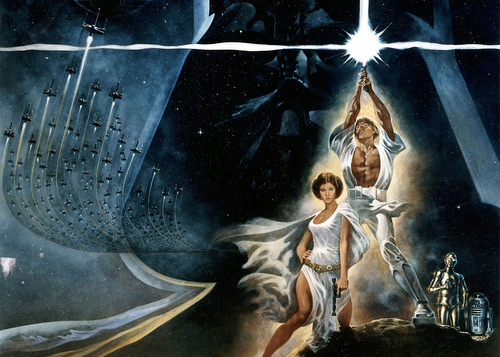
In a 2005 interview Lucas confirmed that “’Star Wars’ was really about the Vietnam War.”
Lucas said that he thought of the tiny, peaceful Ewoks as like Viet Cong fighters battling against the might of the American war machine saying: “That was the period where Nixon was trying to run for another term, which got me to thinking historically about how do democracies get turned into dictatorships? Because the democracies aren’t overthrown; they’re given away.”
The Lord of the Rings Is Really About The Battle of the Somme
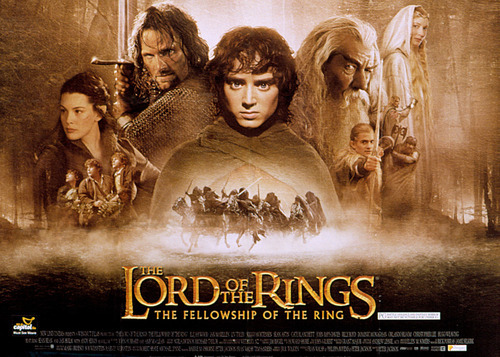
J. R. R. Tolkien’s army unit was sent to the Battle of the Somme in 1916, where 60,000 British soldiers died one day during the infamous ‘over the top’ trench assault. Overall, nearly a million people were killed, making it one of the bloodiest battles in human history.
Speaking later of his experiences in France, Tolkien simply said, “It was like a death.”
As he recovered in hospital, Tolkien wrote his first Middle-Earth story: ’Fall of Gondolin’ a strange, stand-alone tale featuring dragons which were half beast and half machine. These dragons are a metaphor of the tanks, which the British used in the mud of the Somme. Peter Jackson’s depiction of Saruman’s orcs being created recalls this imagery of animal fused with metal, as does his metallic, robot-like depiction of the villain Sauron.
In letters to friends, Tolkien admitted that the hellish marshes which the heroes of ‘The Lord of the Rings’ splash through were directly inspired by his experiences of France. In a letter, he wrote, "The Dead marshes and the approaches to the Morannon owe something to Northern France after the Battle of the Somme."
Observers have also commented on the significance of the One Ring, which is widely considered to represent the atomic bomb.
Godzilla Is Really About Hiroshima
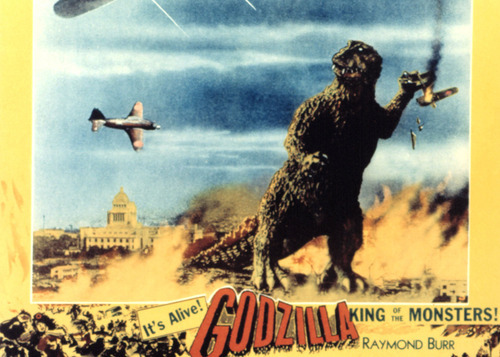
The original black and white ‘Godzilla’ film was made in Japan in the early Fifties when the country was still reeling from the twin nuclear attacks on Hiroshima and Nagasaki.
The first ‘Godzilla’ film includes scenes with scientists carrying Geiger counters taking radiation readings from Godzilla’s radioactive footprints, and the monster is revealed to have been created in a nuclear explosion.
When this news comes out, some characters immediately argue that it must be kept secret.
For Honda and his Japanese audience, the real villain would not have been hard to discern: the escalating Cold War, and in particular the arms race between America and the Soviet Union.
The War of the Worlds Europeans Colonising The Third World
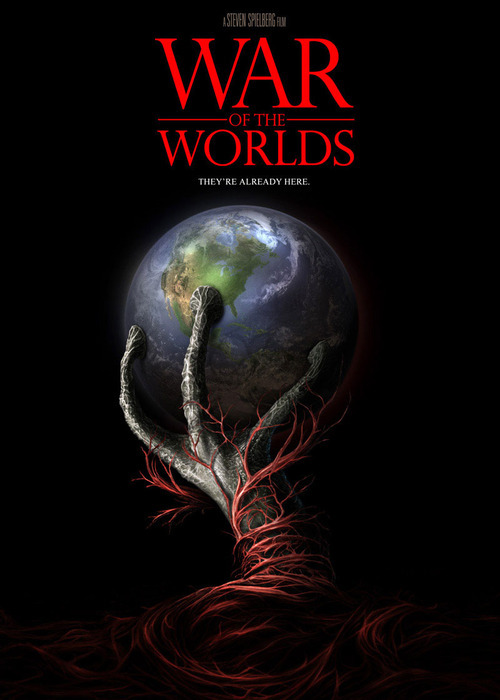
Written in 1898, the science fiction classic ‘The War of the Worlds’ has been filmed many times, but in none of those versions would a viewer suspect that the aliens represent white Europeans hell-bent on colonising the world.
The book was written to horrify readers with a vision of what it would be like if Europe were confronted by a contemptuous, technologically superior force – much in the manner the British Army had as it colonised countries around the world. Wells, a lifelong socialist, was particularly horrified by the war of extermination waged against the Aborigines in Tasmania by British colonial forces.
In the novel, Wells writes, “The Tasmanians, in spite of their human likeness, were entirely swept out of existence in a war of extermination. Are we such apostles of mercy, as to complain if the Martians warred in the same spirit?”
The Dark Knight Is Really About The War On Terror
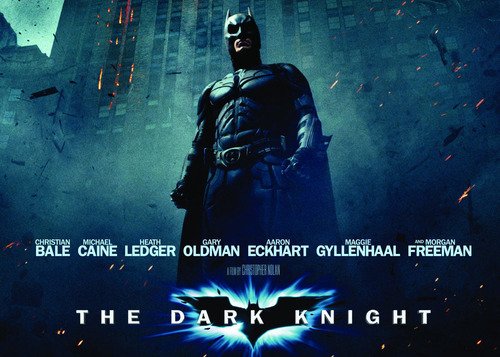
In Christopher Nolan’s ‘The Dark Knight’, despite a truly chilling villain in the form of Heath Ledger’s cackling Joker, it’s no longer clear who the bad guy really is. Is it the psychopathic terrorists who attack Gotham, or is it the increasingly draconian authorities? Parallels with America’s War on Terror run through the film.
The first parallel is the shift from the regular comic book bad guys that shoot lasers from the moon in order to take over the world. This time the threat was more sinister. The Joker blew up public buildings (including a hospital) and convinced weak criminals to become suicide bombers.
Once this realistic threat was established, more similarities can be compared. The Harvey Dent Act is a direct echo of the Patriot Act and there’s the questionable ethics of Batman’s bank of surveillance equipment that enables him to spy on everyone. There’s also the forcible extradition of Lau from Hong Kong, echoing the CIA’s tactics of “extraordinary rendition”.
RoboCop Is Really About Jesus Christ
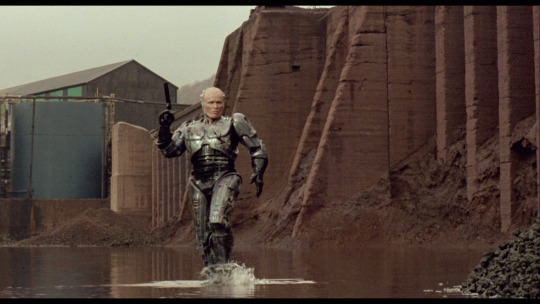
Director Paul Verhoeven has admitted that his 1987 sci-fi classic is basically “the American Jesus” story and the similarities are easy to spot.
"It is about a guy that gets crucified after 50 minutes,” the filmmaker told MTV, “Then is resurrected in the next 50 minutes and then is like the super-cop of the world, but is also a Jesus figure as he walks over water at the end."
He’s a resurrected man on a quest for justice who is violently killed when those closest to him betray him. To earn his redemption he must confront those who betrayed him, and the final scene with Murphy seemingly walking across water is the icing on this thickly-laid metaphor.
Of course, Jesus in the Bible didn’t mete out justice with a handgun, but let’s ignore that for the moment shall we?
Alien 3 Is Really About AIDs
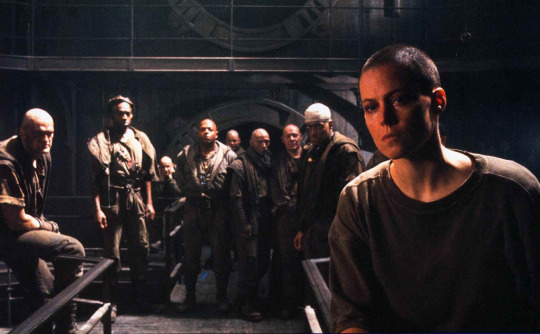
Rolling Stones’ film critic Peter Travers called David Fincher’s feature film debut “the first $50 million thriller that also functions as an AIDS allegory” and it’s a layer of subtext that bears up to scrutiny.
AIDs was a hot topic in the late 80s and early 90s and ‘Alien 3′ is a damning indictment on how America reacted to the so-called “AIDs epidemic”. The deaths of Hicks and Newt highlight the disease’s seemingly random nature. There’s the imagery of shorn hair, Ripley’s “infection”, and an enemy that takes down the weak and strong with ease.
Add to that a reviled colony of men ostracised from society, who’ve taken a vow of celibacy, and a pharmaceutical company that arrives to profit from their pain, and the message is quite clear. As Dillon says: “Why? Why are the innocent punished? Why the sacrifice? Why the pain? There aren't any promises. Nothing certain. Only that some get called, some get saved.”
Groundhog Day Is Really About Zen And The Path To Enlightenment
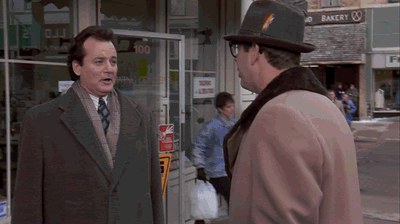
There are many different ways of interpreting Phil Connors’ story. Some say Punxsutawney Phil - the groundhog - is a metaphor for Christ resurrected, while some say the town is Purgatory, but the most compelling explanation for the film comes from director Harold Ramis’ mother-in-law, a Zen Buddhist.
Ramis explained at a lecture in 2009 that she’d called to tell him the abbots and senior monks at her Buddhist retreat had seen the film and loved it, saying “they thought it expressed a fundamental Buddhist concept.” The theory goes that Connors is what Buddhists call a “bodhisattva”, someone “who, motivated by great compassion, has generated bodhicitta, which is a spontaneous wish to attain buddhahood for the benefit of all sentient beings.”
And you just thought it was Bill Murray fooling around.
Toy Story 3 Is Really About The holocaust

Guardian film critic Jordan Hoffman first wrote about this interpretation of Lee Unkrich’s seemingly harmless animated threequel back in 2010 while writing for UGO.
He argues that the toys left behind by Andy when he goes off for college represent the Jews abandoned by their host nations when the Third Reich conquered Europe. The toys discuss their options echoing a scene in Roman Polanski’s Holocaust drama ‘The Pianist’ where they say “We won’t just be abandoned, we can be useful to them”. Buzz steps forward and even suggests hiding in the attic.
Instead they’re sent to Sunnyside, the film’s concentration camp, where they meet Sonderkommandos like Ken who aid the guards and lead the innocent to their deaths. It’s a very grim reading of the film, particular when you consider the incinerator scene, and definitely not the message promoted by Pixar at the time of release.
Who Framed Roger Rabbit Is Really About Gentrification And Segregation
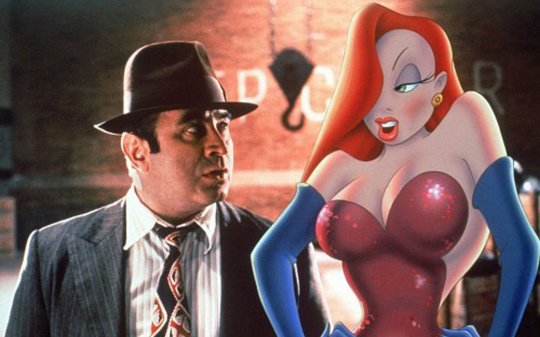
Robert Zemeckis’ 1988 live action animation hybrid was a groundbreaking piece of work and not just for its incredible seamless visual effects. The story of the encroachment of Toon Town can be read as a metaphor for the gentrification of Los Angeles where many poor black people were forced out of their neighbourhoods.
The theory, first discussed on Reddit, argues that the ‘toons, like black people, are largely seen as performers - a nod to Minstrel culture - and Christopher Lloyd’s Judge Doom is a typical Uncle Tom trope, a ‘toon who sells out his own people for his personal benefit.
Jessica Rabbit is “a symbol for women of mixed racial heritage and the way that white men frequently felt confused about their desire for them”, while even the word “‘toon” which is a slur against the cartoon folk, is worryingly similar to a horrific racial slur of years gone by.
Read More - Ridley Scott Accused of White-Washing The Martian - John Goodman Reveals Dramatic Weight Loss - Stars With Helpful Family Connections In Hollywood
#10 Iconic Movies With Dark Hidden Meanings#the dark knight#who framed roger rabbit#the lord of the rings#star wars#toy story#groundhog day
8 notes
·
View notes
Text
14 Star Wars Gifts for Your Favorite Jedi or Sith
Whether you celebrate Christmas, Kwanzaa, or Life Day, the end of the year has come to mean one thing to all people: It’s time for a new Star Wars movie. We all know that one person who’s already in line just to be the first to see the latest installment. So, when you go to visit their tent in front of the cinema, bring them one of these great gifts to help them ring in the Star Wars season.
Sphero R2-D2 App-Enabled Droid
This is the Artoo toy to rule all Artoo toys. Not only is it a handsome, authentic replica of the real deal, but the Sphero R2-D2 is also an incredibly convincing robot. Moving from a tripod to two legs, Artoo’s head swivels and he lights up just like in the movies, making beeps and bwoop sounds as he treks along the floor. No matter the age of your loved one, this is an impressive droid that’s full of the Force. Buy for $179.
Credit: Sphero
This is the Artoo toy to rule all Artoo toys. Not only is it a handsome, authentic replica of the real deal, but the Sphero R2-D2 is also an incredibly convincing robot. Moving from a tripod to two legs, Artoo’s head swivels and he lights up just like in the movies, making beeps and bwoop sounds as he treks along the floor. No matter the age of your loved one, this is an impressive droid that’s full of the Force. Buy for $179.
Porg Everything
Haven’t you heard? Porgs are the greatest thing in Star Wars since Salacious Crumb. So, this holiday, shower them in porg paraphernalia. Porg cufflinks? Dashing! Porg stationary? Yes, please! An electronic dancing porg? It’s so cute! Would they prefer a Funko Pop? It’s here! Buy for $10 and up.
Credit: Thinkgeek
Haven’t you heard? Porgs are the greatest thing in Star Wars since Salacious Crumb. So, this holiday, shower them in porg paraphernalia. Porg cufflinks? Dashing! Porg stationary? Yes, please! An electronic dancing porg? It’s so cute! Would they prefer a Funko Pop? It’s here! Buy for $10 and up.
Lenovo Jedi Challenges
If they ever wanted to become a Jedi, then this is the holiday to make their dream finally come true. This smartphone-powered AR experience puts a highly realistic replica lightsaber in their hand. Between dueling, holochess, and a tower defense game, there are hours of Forceful fun to be had with the Lenovo Jedi Challenges headset. Midichlorians not included. Buy for $199.
Credit: Lenovo
If they ever wanted to become a Jedi, then this is the holiday to make their dream finally come true. This smartphone-powered AR experience puts a highly realistic replica lightsaber in their hand. Between dueling, holochess, and a tower defense game, there are hours of Forceful fun to be had with the Lenovo Jedi Challenges headset. Midichlorians not included. Buy for $199.
The Last Jedi Visual Dictionary
The best thing about a new Star Wars movie isn’t just the movie—it’s also getting new Star Wars books. Easily overlooked, these Visual Dictionaries come packed to the brim with nerdy details you won’t find anywhere else. Written by Lucasfilm Story Group member Pablo Hidalgo, you can bet your credits that this full-color hardbound book will be packed with lovely photos, illustrations, and fascinating anecdotes. Buy for $23.
Credit: amazon
The best thing about a new Star Wars movie isn’t just the movie—it’s also getting new Star Wars books. Easily overlooked, these Visual Dictionaries come packed to the brim with nerdy details you won’t find anywhere else. Written by Lucasfilm Story Group member Pablo Hidalgo, you can bet your credits that this full-color hardbound book will be packed with lovely photos, illustrations, and fascinating anecdotes. Buy for $23.
Starship Blouse
It’s true! Your Star Wars-obsessed friend no longer has to choose between an ordinary Star Wars T-shirt or a nice top. This spaceship-studded chiffon blouse totally proves it. Buy for $40.
Credit: Thinkgeek
It’s true! Your Star Wars-obsessed friend no longer has to choose between an ordinary Star Wars T-shirt or a nice top. This spaceship-studded chiffon blouse totally proves it. Buy for $40.
Death Star Tree Topper
Everyone loves an indoor tree for the holidays, but what if you want some weaponized kyber crystals? The Hallmark Death Star tree topper is the way to go. With its remote control, they can destroy enemies at the push of a button with lights and sounds from the movies. Buy for $100.
Credit: Thinkgeek
Everyone loves an indoor tree for the holidays, but what if you want some weaponized kyber crystals? The Hallmark Death Star tree topper is the way to go. With its remote control, they can destroy enemies at the push of a button with lights and sounds from the movies. Buy for $100.
Star Wars Tiki Mugs
If you’re shopping for someone who loves fruity drinks and Star Wars, then these awesome tikis are guaranteed to be a hit. Even Wuher, the grumpy bartender from the Mos Eisley Cantina, would love these stylish ceramic mugs. This 6-cup set includes a huge Wampa and a tiny Wicket the Ewok. Buy for $80
Credit: Thinkgeek
If you’re shopping for someone who loves fruity drinks and Star Wars, then these awesome tikis are guaranteed to be a hit. Even Wuher, the grumpy bartender from the Mos Eisley Cantina, would love these stylish ceramic mugs. This 6-cup set includes a huge Wampa and a tiny Wicket the Ewok. Buy for $80
Millennium Falcon LEGO
This 7,500-piece LEGO set is the craziest set the company has ever made. It took WIRED four days to assemble the entire thing. Sure, it’s $800, but trust us—it’s so cool. It’s the most we’d ever recommend you spend on a piece of junk. Buy for $800.
Credit: Lego
This 7,500-piece LEGO set is the craziest set the company has ever made. It took WIRED four days to assemble the entire thing. Sure, it’s $800, but trust us—it’s so cool. It’s the most we’d ever recommend you spend on a piece of junk. Buy for $800.
Galactic Necklace
Most Star Wars-themed jewelry is a little tacky, but this necklace is well-designed and super subtle. Featuring a number of famous galactic destinations, along with the Death Star, a TIE Fighter, and an X-Wing. Whether they’re dreaming of cosmopolitan Coruscant or verdant Yavin 4, they��ll be able to visit them all without jumping to lightspeed. Buy for $40.
Credit: Thinkgeek
Most Star Wars-themed jewelry is a little tacky, but this necklace is well-designed and super subtle. Featuring a number of famous galactic destinations, along with the Death Star, a TIE Fighter, and an X-Wing. Whether they’re dreaming of cosmopolitan Coruscant or verdant Yavin 4, they’ll be able to visit them all without jumping to lightspeed. Buy for $40.
littleBits Droid Creator Kit
Getting kids into STEM can be tricky, but if they’re already into Star Wars, this kit could be their gateway drug. Featuring littleBits’ modular computer system and programming app, your Padawan can build a custom droid to her liking, then teach it all kinds of cool tricks. Buy for $100.
Credit: littleBits
Getting kids into STEM can be tricky, but if they’re already into Star Wars, this kit could be their gateway drug. Featuring littleBits’ modular computer system and programming app, your Padawan can build a custom droid to her liking, then teach it all kinds of cool tricks. Buy for $100.
Propel Battle Drones
The closest thing we can get to dogfighting X-Wings and TIE Fighters is finally here. Thanks to Propel’s battle drones, they’ll be able to live out their Death Star trench run fantasies in the backyard or at the neighborhood park. An app-enabled remote control lets you virtually practice your piloting skills before you hit the skies. Buy for $148.
Credit: PropelRC
The closest thing we can get to dogfighting X-Wings and TIE Fighters is finally here. Thanks to Propel’s battle drones, they’ll be able to live out their Death Star trench run fantasies in the backyard or at the neighborhood park. An app-enabled remote control lets you virtually practice your piloting skills before you hit the skies. Buy for $148.
Forces of Destiny Action Figures
These new Star Wars action figures might be aimed at girls, but they’re so cool that boys will want them too. Featuring characters like Rey, Padme, Leia, Ahsoka Tano, and Sabine Wren, the Forces of Destiny line features the ladies of Star Wars, because, isn’t it about time? Buy from $20.
Credit: Hasbro
These new Star Wars action figures might be aimed at girls, but they’re so cool that boys will want them too. Featuring characters like Rey, Padme, Leia, Ahsoka Tano, and Sabine Wren, the Forces of Destiny line features the ladies of Star Wars, because, isn’t it about time? Buy from $20.
Darth Vader Blazer
When they need to intimidate and keep rivals in line, this stylish blazer will make a fine addition to their wardrobe. It’ll remind them to be more than a Needa or a Krennic at work—aspire to become the boss’s right-hand Sith and everything else will fall into place. Buy for $120.
Credit: Thinkgeek
When they need to intimidate and keep rivals in line, this stylish blazer will make a fine addition to their wardrobe. It’ll remind them to be more than a Needa or a Krennic at work—aspire to become the boss’s right-hand Sith and everything else will fall into place. Buy for $120.
Princess Leia Earmuffs
When it’s cold as Hoth outside, they could snuggle up with a Tauntaun, or you could buy them these cool Princess Leia earwarmers. It’s a great way to stay warm and keep the spirit of Carrie Fisher with you wherever you go. Buy for $20.
Credit: Thinkgeek
When it’s cold as Hoth outside, they could snuggle up with a Tauntaun, or you could buy them these cool Princess Leia earwarmers. It’s a great way to stay warm and keep the spirit of Carrie Fisher with you wherever you go. Buy for $20.
When you buy something using the retail links in our buying guides, we may earn a small affiliate commission. Read more about how this works.
When you buy something using the retail links in our buying guides, we may earn a small affiliate commission. Read more about how this works.
More From this publisher : HERE ; This post was curated using : TrendingTraffic
=> *********************************************** See More Here: 14 Star Wars Gifts for Your Favorite Jedi or Sith ************************************ =>
14 Star Wars Gifts for Your Favorite Jedi or Sith was originally posted by A 18 MOA Top News from around
0 notes
Text
The 80s were great.[note]They were also damn terrible. The horrible treatment of LGBTQ+ people, the AIDs crisis, Reagan, the Cold War, Reagan, and so on and so forth. I just like the art…[/note] Great music. Great movies. Great books. Great fashion. Yeah, I said it. Fashion. I love 80s fashion, and I don’t care what you think about that!
Anywho. For today’s Five Faves post, I thought I’d take a stab at listing 80s science fiction movies. I know that the second I click the publish button on this post, I’m going to change my mind about the movies selected below. Oh well…
Here goes:
Aliens (1986)
For me, this movie remains the best entry in the entire franchise. Alien (1979) is a great film, of course, but there’s something about the military SF setting of Aliens that better immerses me in this future world. I also love how Ellen Ripley changes throughout the film, taking on leadership and parental roles. It’s a different Ripley than we saw in the first film, but the change is, for me, part of a progression for the character that is utterly fascinating[note]It’s a progression that collapses in the third (and ONLY other) Alien film, of course. This is actually one of the redeeming qualities of Alien 3.[/note]. Plus, Ripley’s battle with the Xenomorph Queen is hands down one of the best moments in science fiction cinema. You all know this, of course. Most of you love this movie about as much as I do. Go on, admit it.
Enemy Mine (1985)
Fun fact: the only reason I know about this movie, Alien Nation, Star Trek IV, and Quantum Leap is due to my grandma’s insistence that I watch them. This was, I think, her clever attempt to instill certain moral values in me as a child (or, in the case of STIV, to make me laugh). All of these films have a strong moral message, but you can probably credit Enemy Mine and Alien Nation for shaping my young mind into expelling some of the prejudices one gains from living in small, very white towns (or large, very white towns). That moral messaging is part of what makes this movie so good. It’s basically a retread of a familiar story about people on opposing sides of a war being forced to depend on one another to survival, but it’s handled in such a delicate way. Louis Gossett Jr. gives a phenomenal performance as Jeriba Shigan, too.
Predator (1987)
I was tempted to include The Terminator here, but I actually prefer Predator a tad more. There are a couple of reasons for that: 1) this movie terrified me a lot more than The Terminator; and 2) I think Arnie gives a strong performance here, especially since he’s actually asked to do something other than be a robot. Predator is a classic action film with some amazing shots. I get chills every time Schwarzenegger stands out in the open and roars into the night. It’s such a primal moment, and the sequence that follows is beautifully rendered (ditto Schwarzenegger covered in mud). And what about the Predator himself? He’s horrifying in all the right ways. He has the look of a great terror AND he has the prowess of one. Too bad about Dillon, Poncho, Mac…all of them…
Star Wars V: The Empire Strikes Back (1980) AND Star Wars VI: Return of the Jedi (1983)
#gallery-0-6 { margin: auto; } #gallery-0-6 .gallery-item { float: left; margin-top: 10px; text-align: center; width: 50%; } #gallery-0-6 img { border: 2px solid #cfcfcf; } #gallery-0-6 .gallery-caption { margin-left: 0; } /* see gallery_shortcode() in wp-includes/media.php */
I’m a Star Wars fan. Are you even remotely surprised that two of the original movies would show up on this list of 1980s favorites? Look, I don’t need to re-hash the full story of why Star Wars is important to me. I’ve loved these movies since I first watched them on VHS. I will always love them. So many of my greatest memories involve Star Wars things. Empire Strikes Back is, of course, the best of the original trilogy. It is a beautiful film with a complex narrative arc — and, yes, it actually has an ending (FFS, it has an ending). Return of the Jedi is a less precise film, but I will always have a special fondness for it. As a kid, I used to love those space battles more than almost anything else. They were incredible (and still are). As an adult, I love what the film does with Luke and Vader or what the film has to say about the Empire through the Ewoks. Return may not be as good as Empire for all sorts of technical reasons, but it’s the film I return to more than any other for the sheer joy it brings me.
Star Trek II: Wrath of Khan (1982)
Finally, I have to include the greatest film from the other side of the Great Geek Divide. You know why. Wrath of Khan is fantastic. It’s approach to Kirk’s age and the madness that seeking revenge can produce is one of the reasons I can re-watch Wrath over and over. And the story behind the film — that fans watching the movie actually thought Spock was a goner — just adds a sheen of wonder to the whole thing. Imagine living in a time when you didn’t have the constant rumor mill trying to spoil everything for you. Imagine thinking your favorite hero was truly dead. Even without that, Spock’s death is absolutely gut-wrenching. You can feel the pain in the room (and it’s all acted pain…). It’s just so good.
And there you have it. What are your five favorite science fiction movies of the 80s?
A new Five Faves post has arrived. In this edition, I talk about 80s science fiction movies. Feel free to offer your favorites in the comments! The 80s were great.They were also damn terrible. The horrible treatment of LGBTQ+ people, the AIDs crisis, Reagan, the Cold War, Reagan, and so on and so forth.
0 notes